What is Enterprise Project Management?

In large organizations, managing multiple projects across departments can quickly become chaotic, especially when each team uses different tools, processes, and reporting methods. Without a centralized approach, project updates become siloed, communication is inconsistent, and scaling operations becomes a challenge. According to Grammarly, 72% of business leaders report that effective communication has led to increased productivity.
Enterprise Project Management (EPM) addresses these challenges by introducing structure, transparency, and consistency across the organization. It enables teams to coordinate efforts, track progress uniformly, and follow shared best practices, ultimately helping leaders make informed decisions faster.
In this article, we’ll explore what EPM is, how it differs from traditional project management, and how enterprise project management tools, such as Meegle, support standardization and improved cross-team visibility.
What is enterprise project management?
Enterprise project management (EPM) is the practice of managing multiple projects across an organization using standardized processes and centralized oversight. It ensures that every project aligns with company-wide goals, helping teams allocate resources effectively and maintain consistent execution, even as they scale operations.
The primary purpose of EPM is to link high-level business objectives with day-to-day project execution, making sure that initiatives are completed on time, within budget, and in support of broader company priorities. It also helps manage interdependencies between projects to avoid duplication, delays, or resource conflicts.
 Driving clarity in enterprise project execution - Source: Freepik
Driving clarity in enterprise project execution - Source: FreepikEPM is typically overseen by an Enterprise Project Management Office (EPMO), a centralized body that operates at a strategic level. The EPMO often reports directly to executive leadership, such as the Chief Operating Officer (COO) or a designated project executive.
In some organizations, responsibilities are shared or supported by other senior roles, such as enterprise delivery managers or senior project managers. These roles may help execute EPMO strategies or oversee enterprise-wide project strategies.
In addition to project portfolio management, the EPMO may also:
- Provide mentorship to project managers: Offer guidance and support to enhance project management skills and effectiveness
- Ensure projects align with high-level business objectives: Make certain that projects contribute to the organization's strategic goals
- Oversee and coordinate the efforts of project management offices (PMOs): Manage and harmonize the activities of various PMOs within the organization
- Resolve or mitigate issues in projects: Address and manage challenges to keep projects on schedule
- Establish guidelines and best practices for project management teams: Develop standards to improve project management processes
- Improve resource management: Optimize the allocation and utilization of resources across projects
Ultimately, EPM brings structure, visibility, and consistency to complex environments, helping organizations deliver more value through every project.
Enterprise project management vs Traditional project management
Here’s a clear comparison table highlighting the key differences between enterprise project management and traditional project management:
| Aspect | Traditional project management | Enterprise project management |
|---|---|---|
| Focus | Managing a single project with specific goals | Managing multiple projects to support overall business objectives |
| Objective | Successful completion of an individual project | Delivering long-term value to the organization |
| Scope | Narrow, project-specific | Broad, spanning various teams and departments |
| Ownership | The project manager or team leads the project | The Enterprise Project Manager or EPMO provides strategic oversight and coordinates efforts across multiple projects to maintain alignment with organizational goals |
| Decision-making | Project-level decisions made by individual project managers | Strategic decisions are made based on business priorities |
| Reporting structure | Reports to a department head or project sponsor | Reports to senior leadership, like the COO or the CPO |
| Standardization | Lacks enforced consistency across departments or projects | Uses standardized tools and workflows across all projects |
| Metrics for success | Time, cost, scope, and quality of a single project | Business impact, resource optimization, and portfolio performance |
| Tools used | Project-specific tools (e.g., MS Project, Trello) | Organization-wide platforms (e.g., Meegle, enterprise PM tools) |
| Resource management | Resources managed within a project | Resources allocated based on organizational priorities across all projects |
Benefits of enterprise project management
Despite their scale, many enterprise projects drift without clear direction or coordination. Enterprise project management brings structure, clarity, and cross-team rhythm, supporting every initiative to move with purpose and impact.
Here are four ways EPM benefits your projects:
EPM enables proactive resource planning
Challenge: Departments often work in silos, unaware of overlapping demands. Managers often struggle to detect resource overloads or idle capacity, which can lead to delays and missed deadlines.
Benefit of EPM: With forecasting tools, EPM identifies resource conflicts early. Managers can adjust timelines or redistribute workloads before problems escalate, keeping key projects on track.
EPM standardizes workflows and communication
Challenge: Teams use different platforms and reporting methods, creating confusion and delays. Disconnected updates make it hard to coordinate tasks across functions.
Benefit of EPM: EPM replaces scattered systems with shared templates and update schedules. Cross-functional teams can track progress, dependencies, and timelines on a unified platform.
Example: Companies with strong collaboration experience have 23% higher profits, 18% greater productivity, and 18–43% lower turnover.
EPM gives leaders real-time portfolio insights
Challenge: Without centralized tracking, issues go unnoticed until they affect multiple projects. Duplicate work and missed dependencies increase delivery risks.
Benefit of EPM: Dashboards highlight delays, risks, and overlaps across projects. Leaders can act early by resolving blockers, reallocating resources, and eliminating redundant tasks.
EPM drives consistent, high-quality execution
Challenge: Some teams follow structured methods, while others rely on ad hoc processes. This variation impacts quality, predictability, and scalability.
Benefit of EPM: When you adopt proven frameworks like Agile or PMBOK, EPM creates repeatable workflows and measurable benchmarks. Teams deliver more accurate estimates and improve reporting.
“Benchmarking the project management maturity of your organization to that of high-performing organizations, you’ll have a guide to improving your project management and organizational success.”
-- Kent Crawford, a project management expert
With such compelling results, it’s no surprise that demand for skilled project managers continues to grow, emphasizing that project maturity is no longer optional but essential for organizational success.
Did you know? The Project Management Institute (PMI) projects a 33% increase in demand for project managers by 2027.
Elements of enterprise project Management
The PMI defines seven key elements that form the foundation of an effective project management model for enterprises. Some of these expand traditional project management practices to an organizational scale, while others are specific to the EPMO.
In the sections that follow, we’ll also highlight how Meegle supports each of these elements in practice.
1. Risk analysis
Effective risk analysis is crucial for managing the uncertainty associated with large-scale, cross-functional projects. In enterprise environments, this means continuously identifying and evaluating potential threats, whether operational, financial, or strategic, that could delay timelines, overextend budgets, or compromise business outcomes.
Because risks in enterprise settings span teams, tools, and timelines, successful mitigation depends on clear accountability and consistent tracking mechanisms.
To bring structure to this process, EPM frameworks recommend applying standardized practices such as:
- Clear accountability: Designating a central stakeholder (often from the EPMO or a senior program lead) to ensure that project managers follow through on mitigation strategies
- Standardized metrics: Using consistent criteria to evaluate both projected risks and emerging issues, including measures like likelihood, impact, and contingency status
- Robust estimation methods: Applying forecasting techniques, such as Monte Carlo simulations or three-point estimating, to model uncertainty and allocate buffer time or resources proactively
However, visibility remains the foundation of enterprise risk management. Without a shared view of how risks evolve across departments and portfolios, even the most detailed plans fall behind.
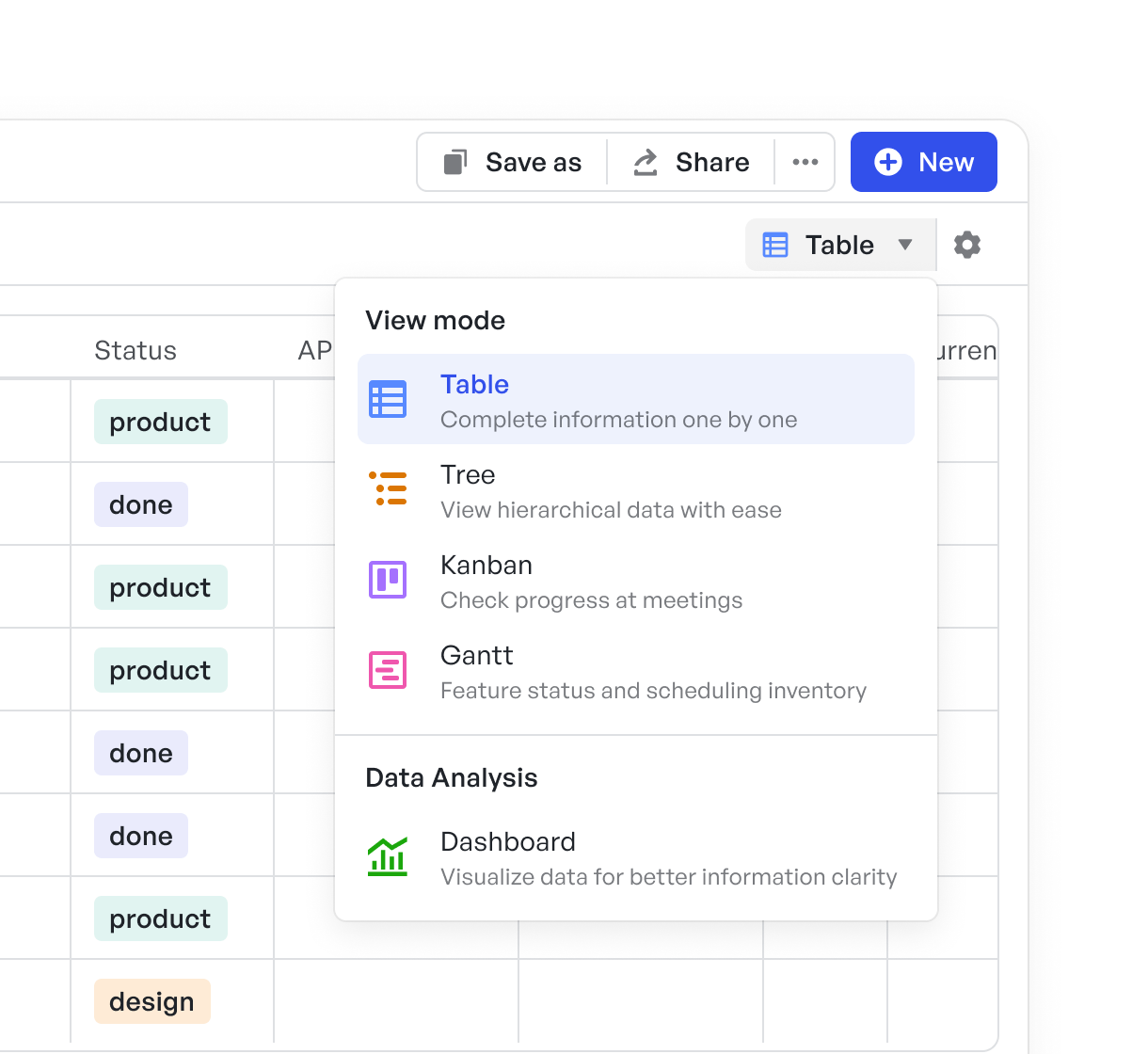 Track, organize, and prioritize tasks effectively
Track, organize, and prioritize tasks effectivelyWith Meegle’s multiple views, risk indicators can be identified in real time across departments, portfolios, or strategic initiatives. Whether you're managing product portfolios or coordinating cross-functional delivery, Meegle’s views help surface risk in context, so it's easy to spot what’s off track before it escalates:
- List View: Displays tasks in a streamlined format with sorting and filtering, making it easy to spot overdue or high-risk items
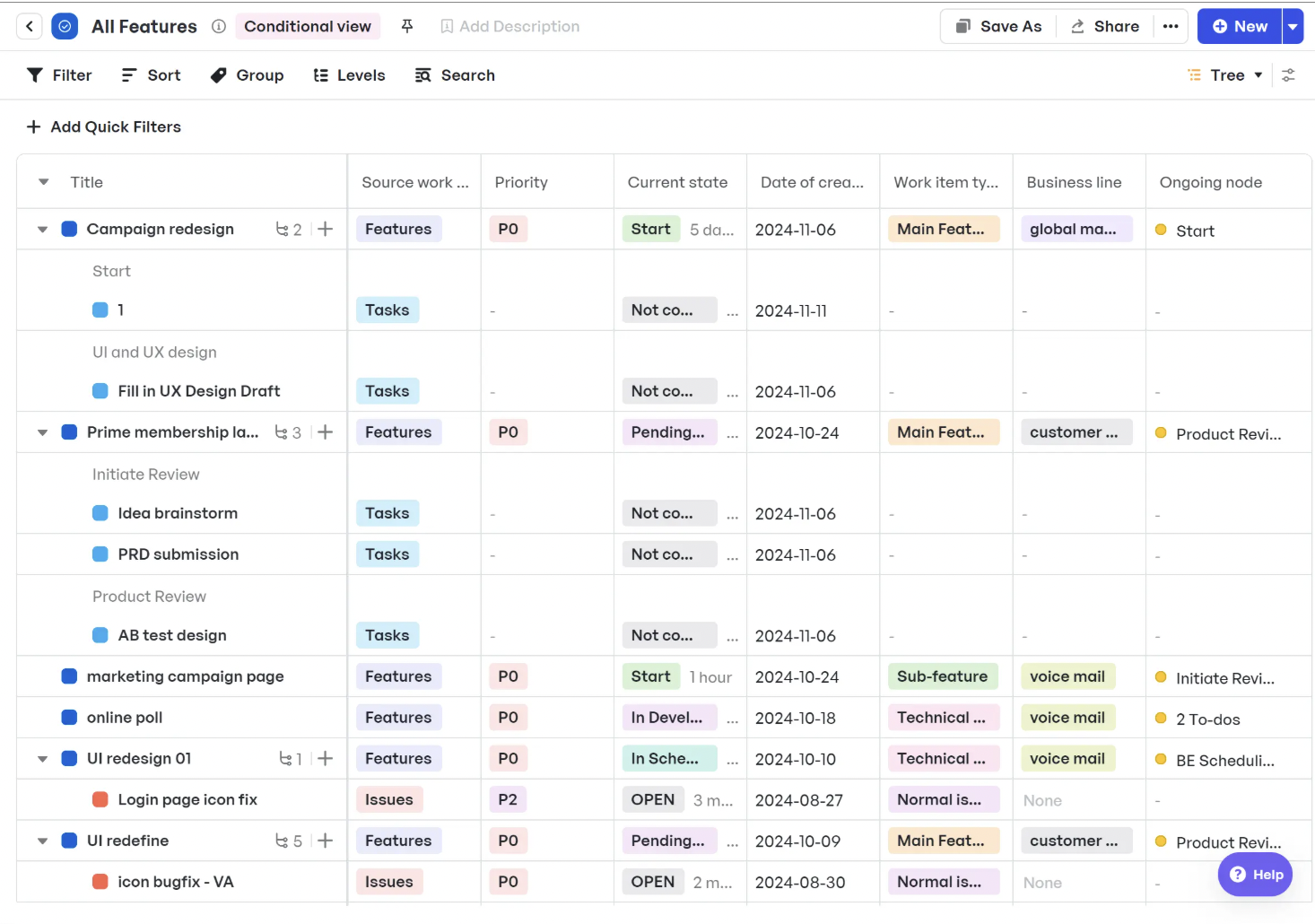 Use a clean, sortable list to prioritize work and track progress at a glance
Use a clean, sortable list to prioritize work and track progress at a glance- Table View: Captures every initiative along with its real-time status, so risks become visible as milestones slip or blockers emerge
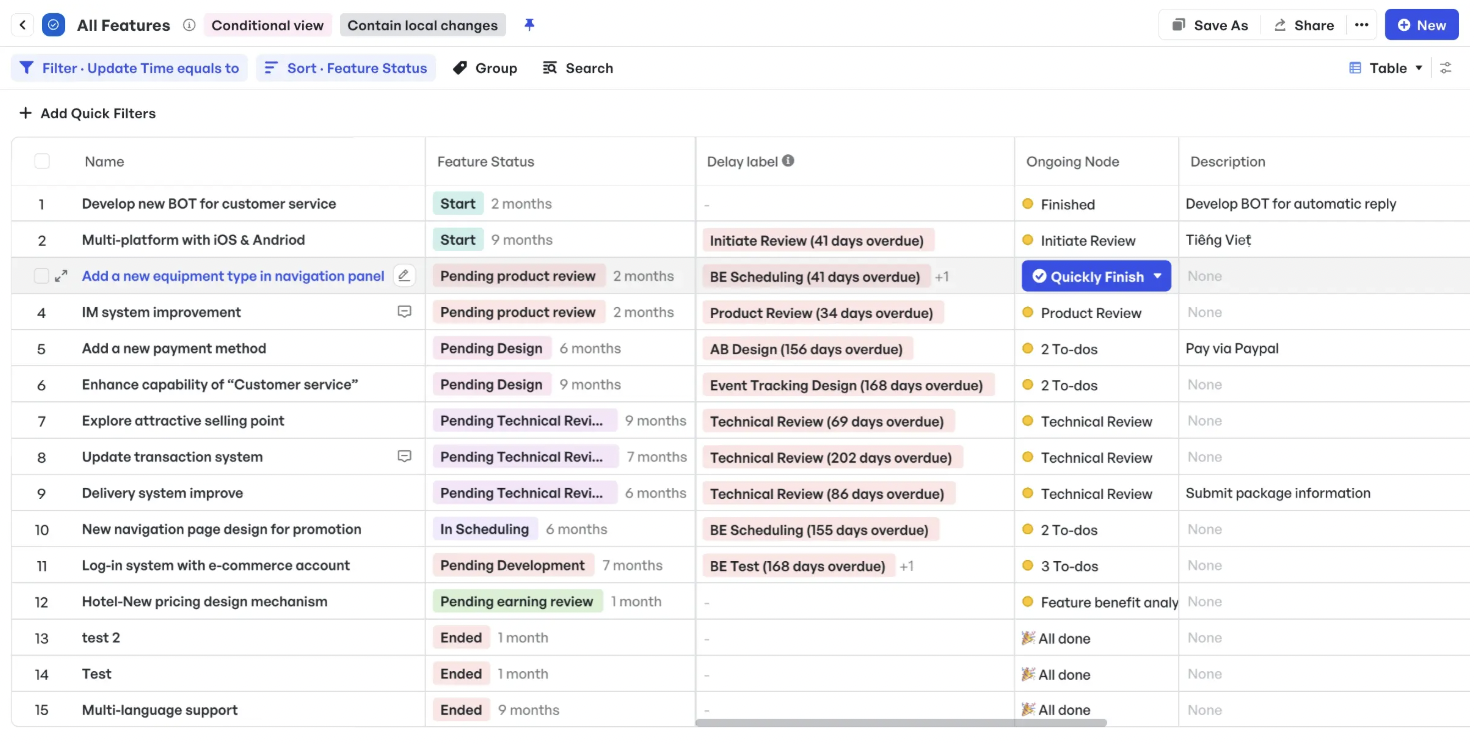 Monitor project status across initiatives with a spreadsheet-style layout
Monitor project status across initiatives with a spreadsheet-style layout- Kanban View: A drag-and-drop layout that visualizes work by status, helping teams identify stalled items or overloaded stages
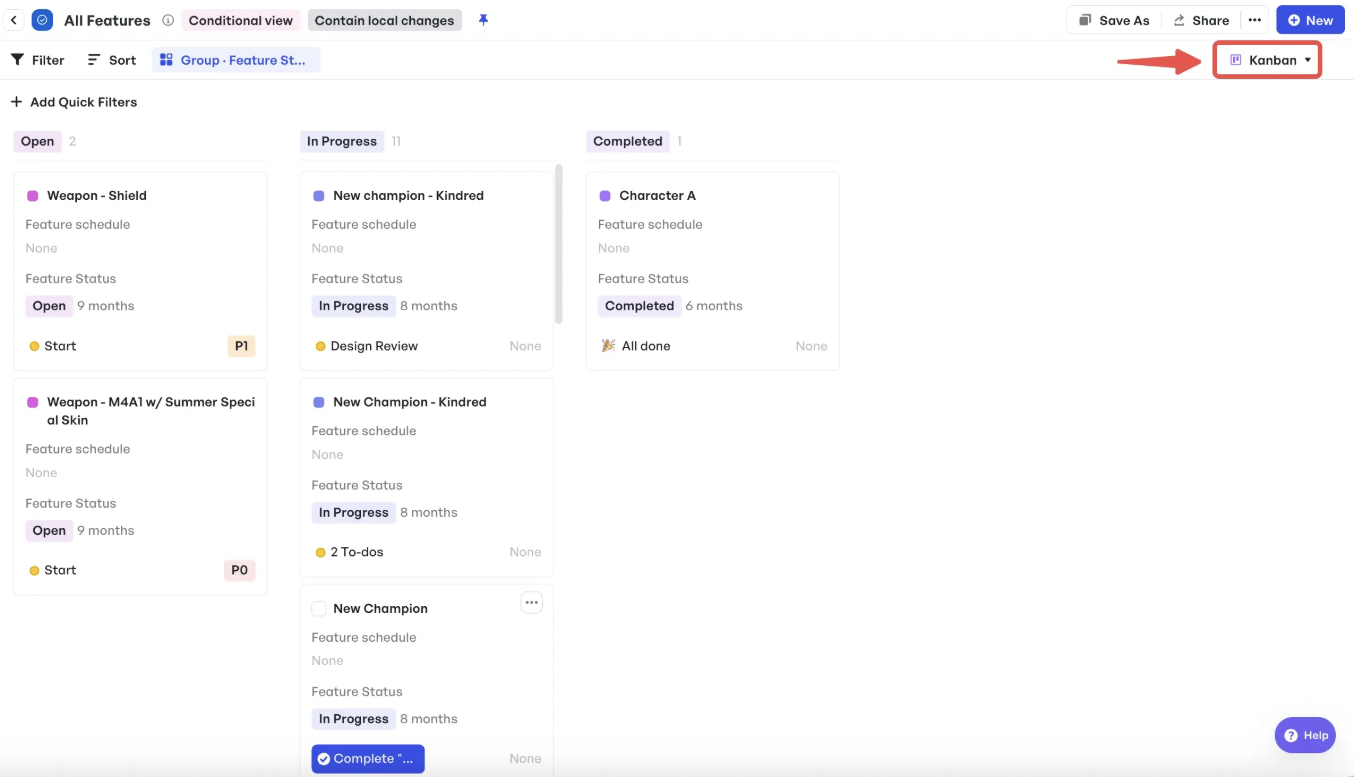 Visualize workflows clearly with a stage-by-stage Kanban view
Visualize workflows clearly with a stage-by-stage Kanban view- Gantt View: A timeline-based view that highlights dependencies and scheduling conflicts, critical for identifying risks early
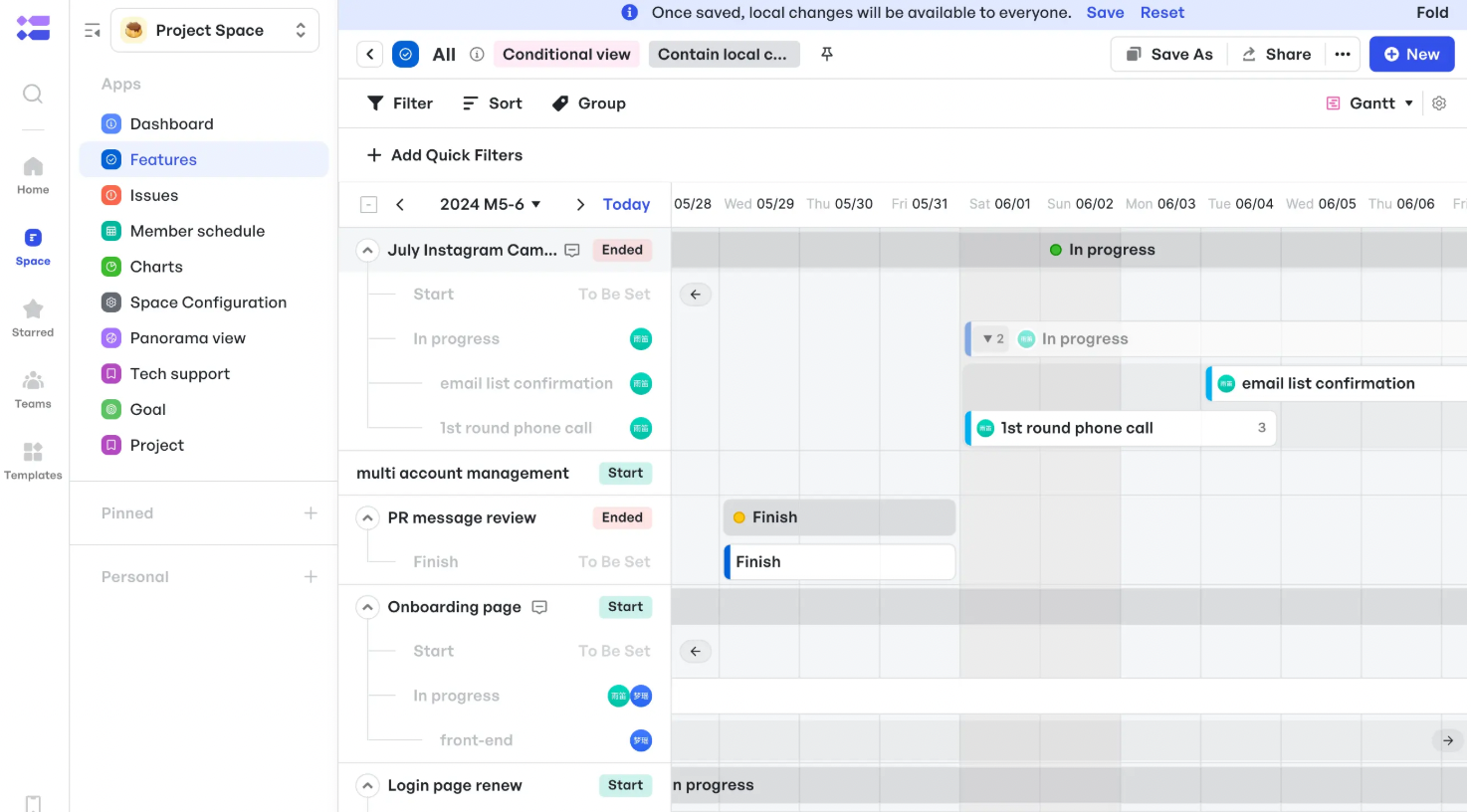 Map dependencies and timelines to anticipate and prevent scheduling conflicts
Map dependencies and timelines to anticipate and prevent scheduling conflicts- Tree View: Maps tasks hierarchically, allowing you to trace how delays or risks cascade through parent and child tasks
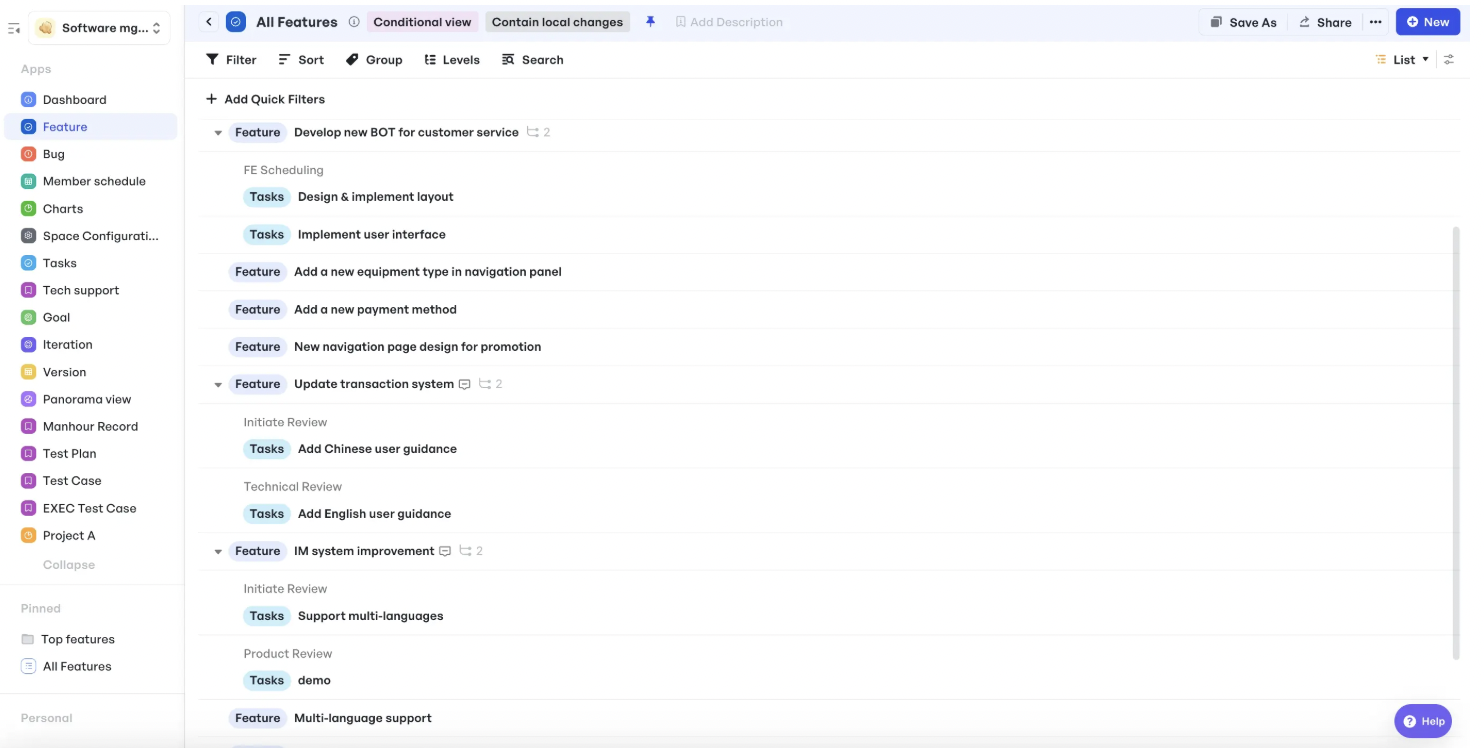 See how delays ripple across parent-child tasks for better impact analysis
See how delays ripple across parent-child tasks for better impact analysis- Panorama View: Provides a high-level, cross-team overview that integrates data across projects, ideal for surfacing portfolio-level risks and prioritizing enterprise-wide interventions
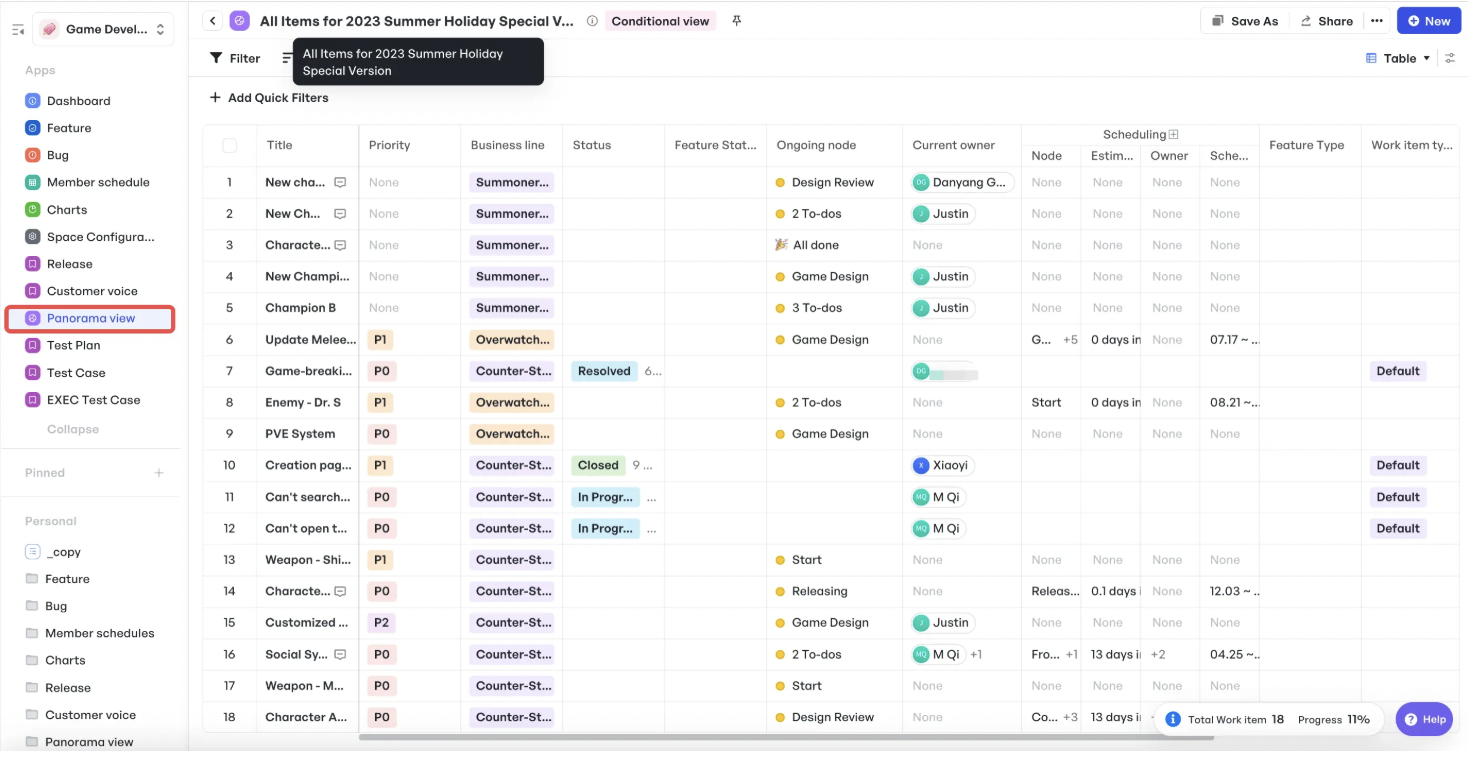 View cross-project data to identify risks, trends, and portfolio-wide priorities
View cross-project data to identify risks, trends, and portfolio-wide prioritiesBy integrating these views into your EPM practices, Meegle gives enterprise leaders and teams the real-time visibility they need to make informed decisions and enhance their risk management processes, without compromising agility or alignment.
2. Structured estimating
Estimating time, cost, and resources is essential in project management, but in an enterprise environment, informal or inconsistent estimating practices can quickly create downstream chaos. That’s why EPM places strong emphasis on structured estimating, setting defined standards to ensure predictability, accountability, and repeatability across all projects.
The EPMO’s role in structured estimating
The EPMO typically leads this effort by:
- Defining a standard delivery lifecycle that all project managers follow
- Providing historical benchmarks based on completed projects to improve accuracy
- Training teams on proven estimating techniques, such as:
- Three-point estimation (optimistic, pessimistic, and most likely scenarios)
- The Delphi method, which gathers expert input to establish consensus
- Bottom-up estimation for breaking down complex work into manageable, measurable units
- The Delphi method, which gathers expert input to establish consensus
- Three-point estimation (optimistic, pessimistic, and most likely scenarios)
By implementing these practices, project teams can build more realistic schedules, budgets, and staffing plans. But applying them consistently across dozens of projects and stakeholders requires more than just guidelines. It requires tools that support and enforce structured estimating at every stage.
How Meegle supports structured estimating
Meegle is designed to help enterprise teams apply estimation standards consistently by guiding them through built-in workflows and templates. Here’s how Meegle suports estimating discipline:
- Status-based workflows guide teams through a consistent estimation process. From initial scoping to budget and resource planning, each stage must be completed and reviewed before moving forward.
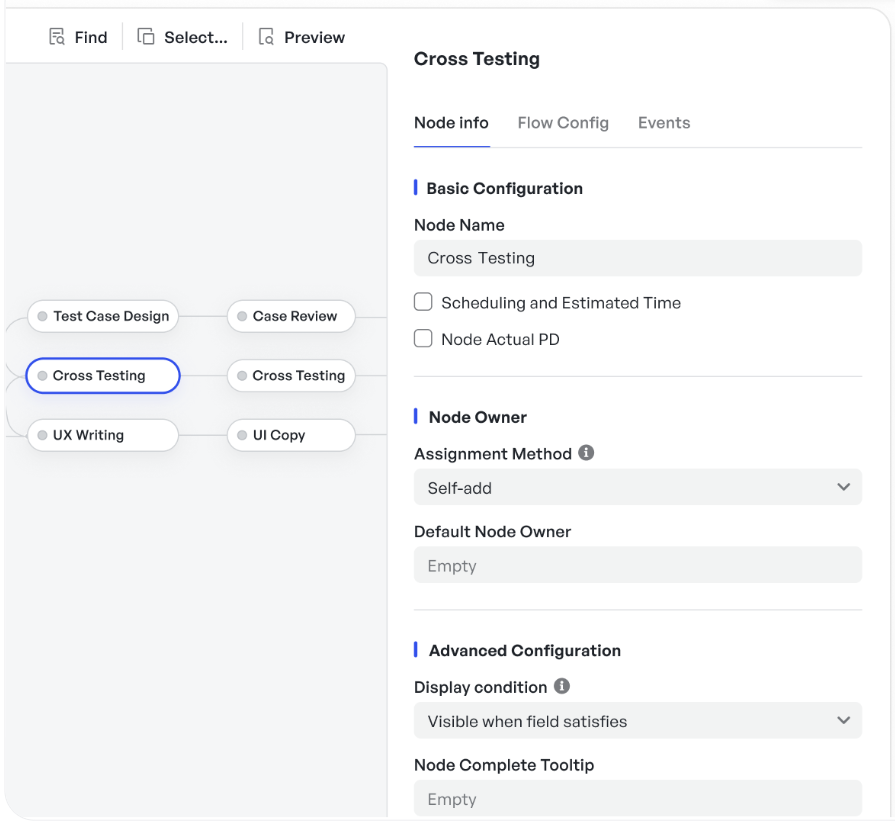 Meegle's node-driven workflow
Meegle's node-driven workflow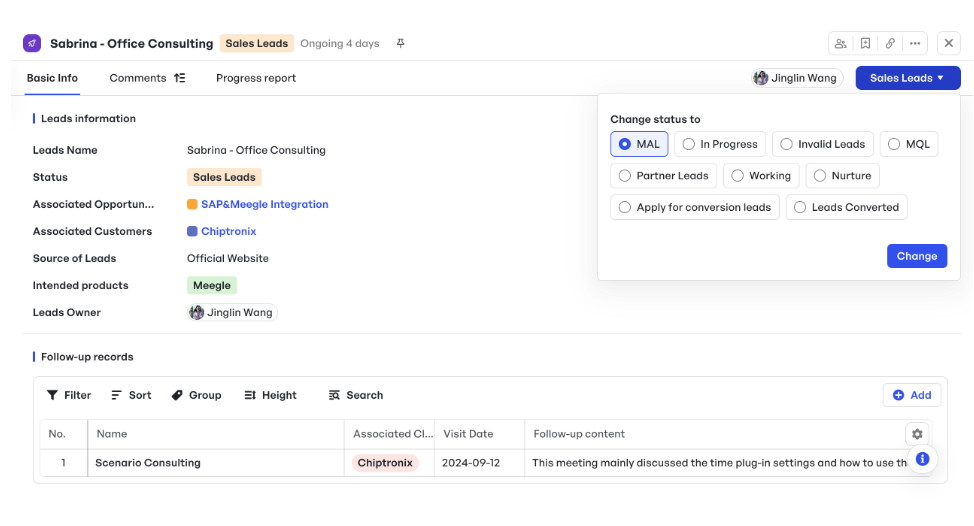 Track and update tasks instantly at every stage using a status-based workflow
Track and update tasks instantly at every stage using a status-based workflow- Stakeholder engagement tracking is built into Meegle’s workflow. Estimates progress through defined approval stages—from Not Initiated to Engaged, Under Review, and Closed, making it clear who is responsible for reviewing and signing off on each stage. This structure facilitates the formal validation of estimates before work begins, rather than relying on informal consensus for approval.
To support consistency even further, Meegle offers standardized templates for estimating scope, timelines, costs, and resource allocations. For Agile teams, Meegle also includes a fully customizable Agile Development Template that streamlines the estimation and planning process. This template includes modules for managing Epics, Stories, Sprints, task tracking, progress updates, and project scheduling, allowing teams to adapt as priorities shifts while maintaining structured practices.
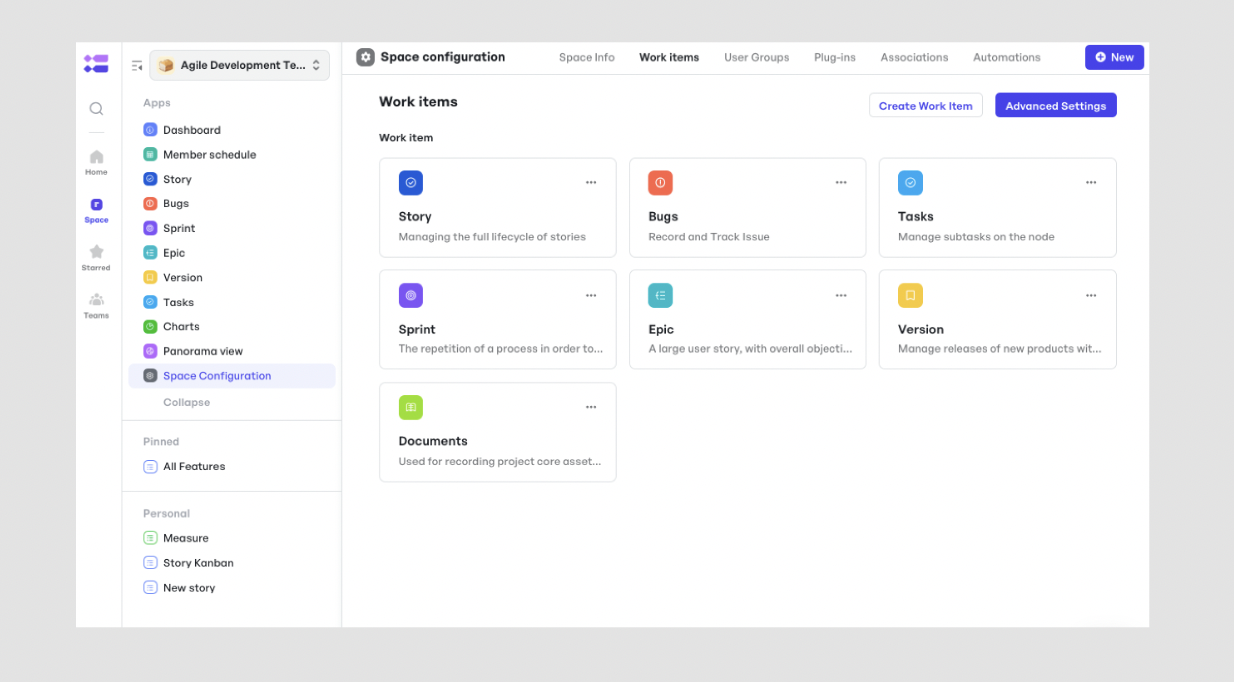 The Agile Development Template by Meegle
The Agile Development Template by MeegleAdditionally, Meegle’s Work Items connect estimation directly to project execution. For example:
- Product backlogs help tie estimates to the highest-impact work
- Milestone forecasting links estimates to delivery dates, helping teams align expectations early
- Progress tracking shows where tasks are over- or under-performing against their original estimates, providing real-time feedback for future planning
Whether you're estimating a 3-week sprint or a multi-year transformation program, Meegle’s capabilities help EPMOs enforce consistency without sacrificing agility or speed.
3. Project reviews
Periodic project reviews are essential because they keep enterprise initiatives aligned with strategic goals, track evolving risks, and monitor compliance with project standards. Unlike ad hoc check-ins, EPM-driven reviews follow a structured cadence to assess not just progress but also compliance with project standards, evolving risks, and stakeholder alignment. The EPMO typically facilitates four types of reviews:
- Project commitment reviews to validate scope, feasibility, and resource alignment before work begins
- Startup reviews to ensure all planning elements like estimations and risk plans are in place
- Progress reviews to assess timeline adherence, budget consumption, and emerging issues
- Close-out reviews to evaluate final deliverables, document lessons learned, and measure impact
A common practice during these reviews is applying a Red/Yellow/Green (RAG) status to key project dimensions such as delivery, client engagement, team performance, and budget control. This color-coded approach helps escalate urgent issues in management meetings and directs attention to where it's needed most.
To support these reviews, Meegle provides consistent, real-time reporting that equips leadership with actionable insights. There is no need for manual updates.
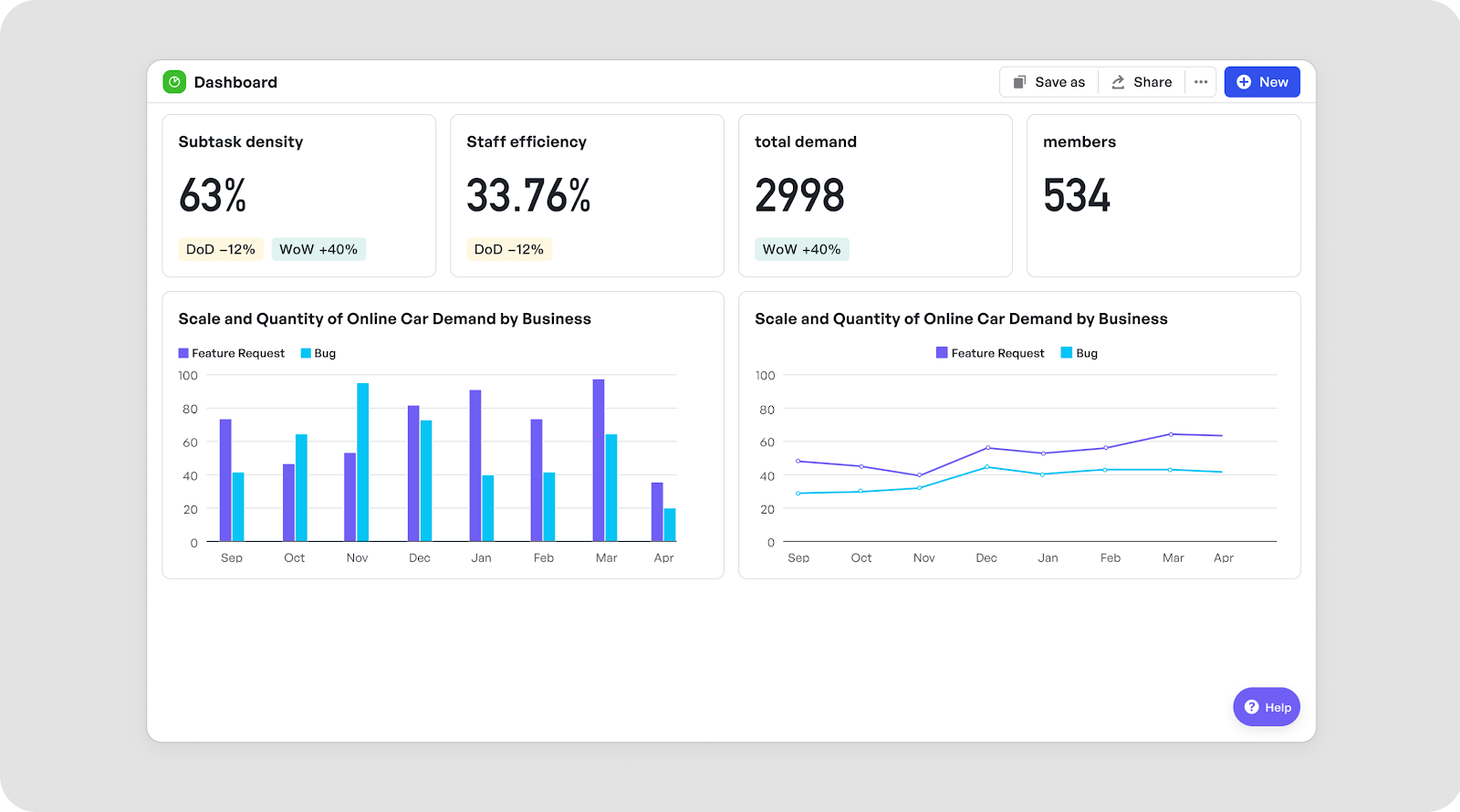 Identify patterns, surface trends, and extract insights that help enterprise teams make precise, informed decisions
Identify patterns, surface trends, and extract insights that help enterprise teams make precise, informed decisionsUsing Meegle’s real-time dashboards and charts, your team can visualize the status of ongoing projects with color-coded indicators, milestone tracking, and customizable metrics. Filters enable you to slice this data by project, department, role, or business unit, allowing reviewers to focus on the areas most relevant to them.
For example:
- Track delivery performance with metrics like lead time, sprint velocity, and milestone completion to confirm timelines are realistic and achievable
- Monitor budget health and resource utilization through dynamic charts that update automatically as inputs change
- Incorporate stakeholder sentiment into review dashboards for a more complete view of project health and alignment
Formal checkpoints are built directly into Meegle’s workflows, helping EPMOs run reviews at consistent intervals across all teams. From project startup reviews to close-out retrospectives, Meegle helps make every review structured, transparent, and closely tied to enterprise objectives.
4. Project management coaching
Project management can be demanding, especially at the enterprise level. Project managers must coordinate cross-functional teams, meet strict deadlines, and manage diverse stakeholder expectations. These challenges create a complex environment that can overwhelm even experienced professionals without proper coaching.
That’s why EPMOs play a critical role in nurturing talent. They invest in PMOs by:
- Providing access to structured training programs, either in-house or through external experts, focused on both technical and leadership skills
- Assigning mentors who support project managers throughout the project lifecycle, from planning and execution to problem-solving and decision-making
This hands-on coaching improves delivery outcomes, ensures consistent execution, and builds long-term project leadership capabilities within the organization.
To support learning and role-specific excellence, Meegle simplifies onboarding and upskilling with intuitive tools, guided templates, and customizable views that provide role-tailored perspectives, helping PMO, finance, and delivery teams access the information and workflows they need.
Meegle reduces onboarding friction by guiding new users through each project phase with built-in templates and contextual prompts.
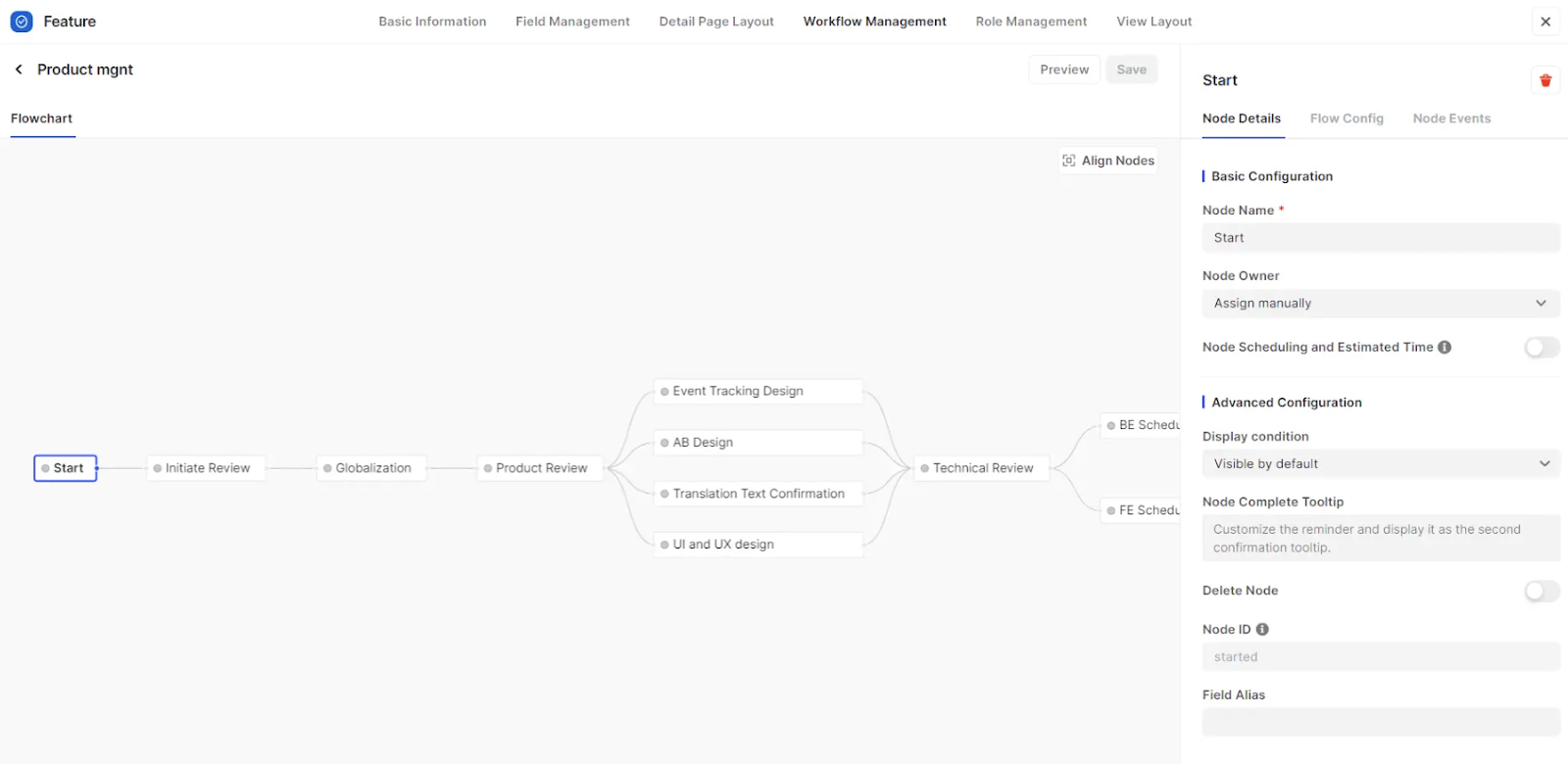 Customize workflows to match your project or business requirements using ready-to-use, adaptable workflow templates
Customize workflows to match your project or business requirements using ready-to-use, adaptable workflow templatesFor example, creating and managing workflows is designed to be effortless:
- Click “Add a New Workflow” to begin.
- Name the workflow, for example, Activity Feature.
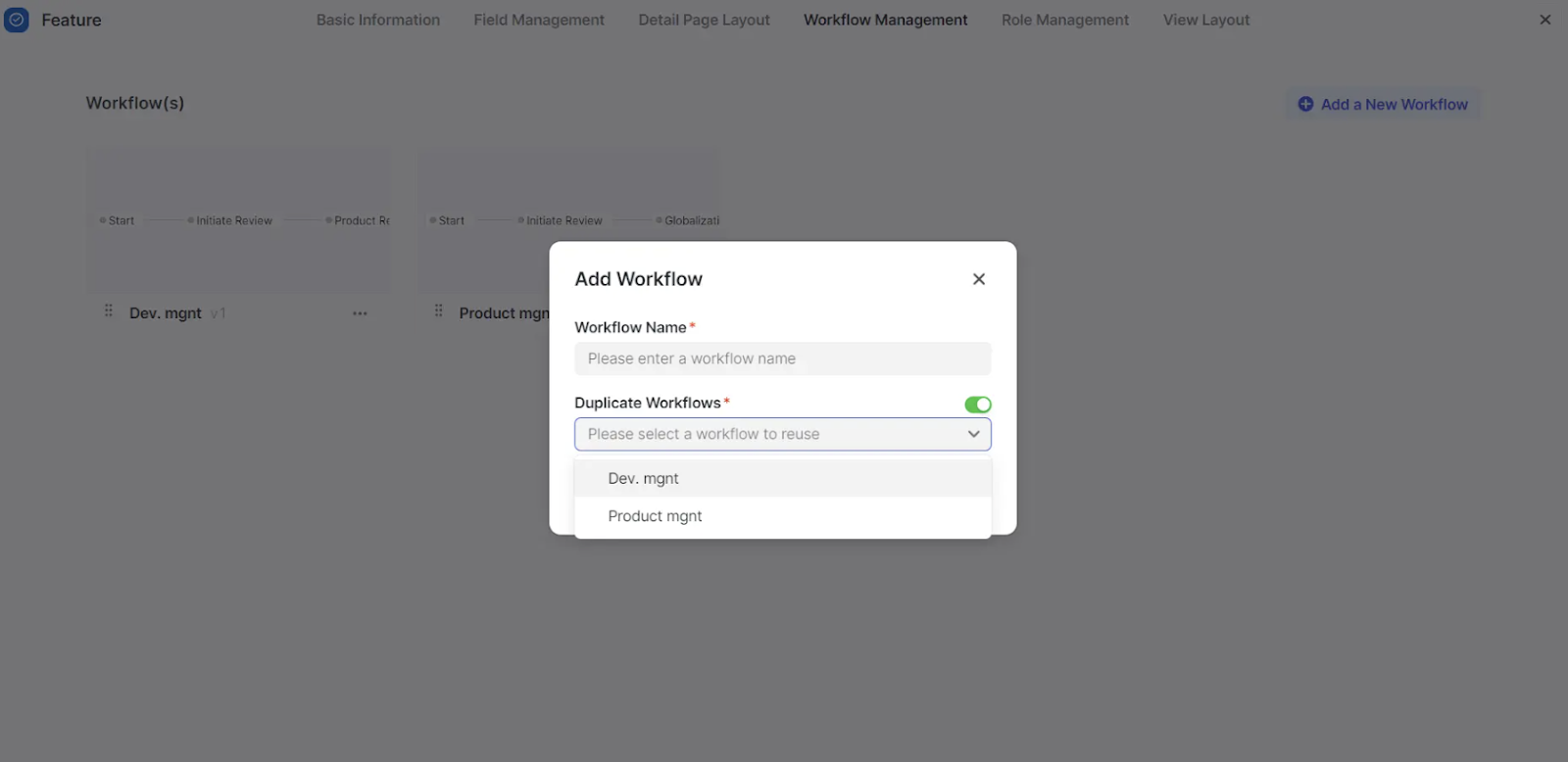 Select the Duplicate Window to create a new workflow template based on an existing one
Select the Duplicate Window to create a new workflow template based on an existing one- Turn on “Duplicate Workflow” to base it on an existing one, or keep it off to start fresh.
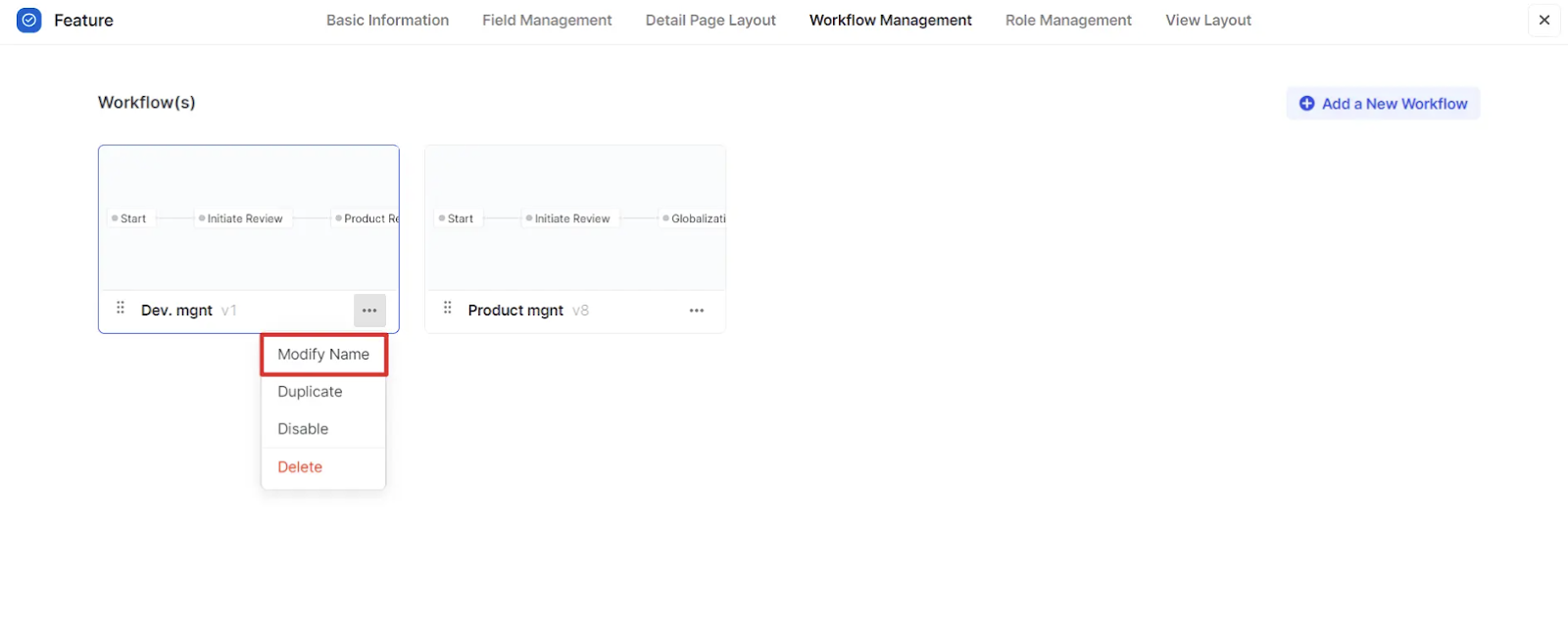 Modifying a workflow template
Modifying a workflow template- To rename a template, click the ellipsis (…) on the template card, then choose “Modify Name.”
- Use the Duplicate function to create editable copies for different teams or project types.
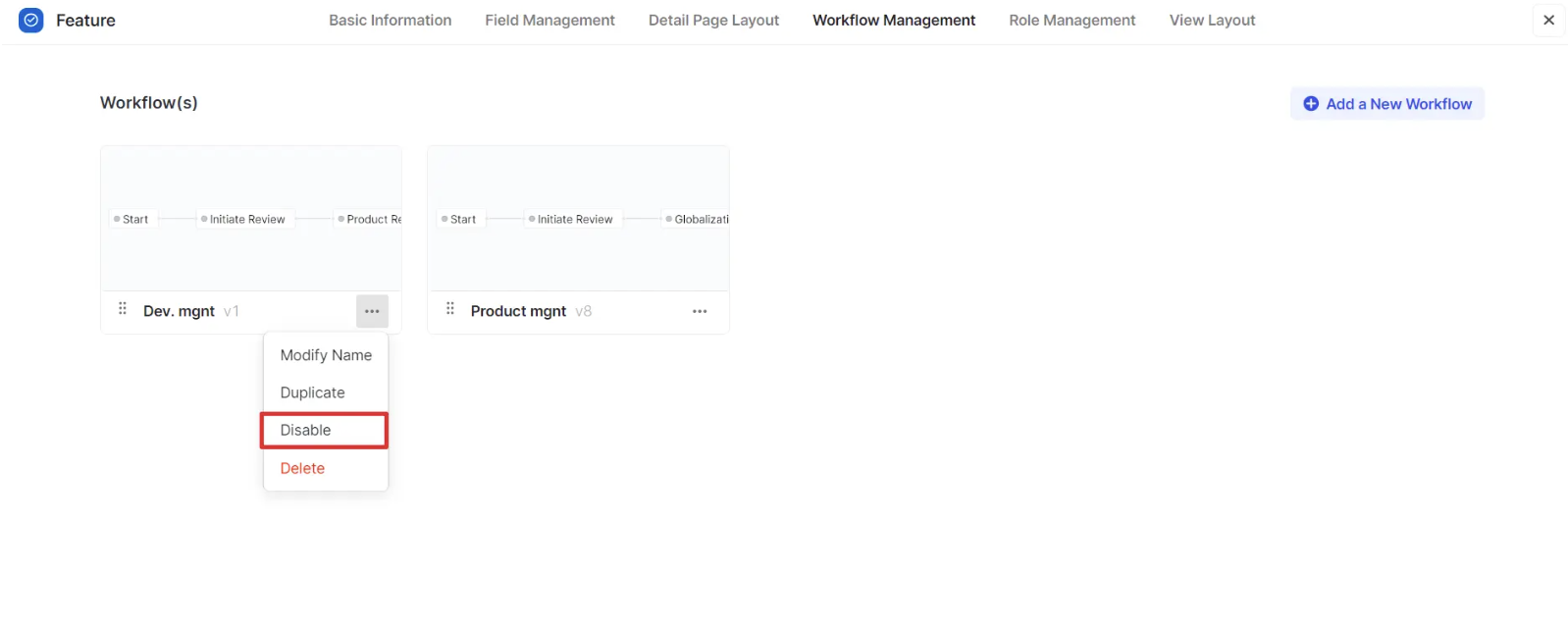 Deactivate the template if your business direction shifts, while keeping the original workflow intact for future reference
Deactivate the template if your business direction shifts, while keeping the original workflow intact for future reference- Templates no longer in use can be disabled—they’re still available for filtering but not for new work items.
- If a workflow has no active work items, it can be deleted; if items are still live, Meegle prompts you to resolve or disable the template instead.
This allows project teams to standardize best practices while retaining the flexibility to adapt.
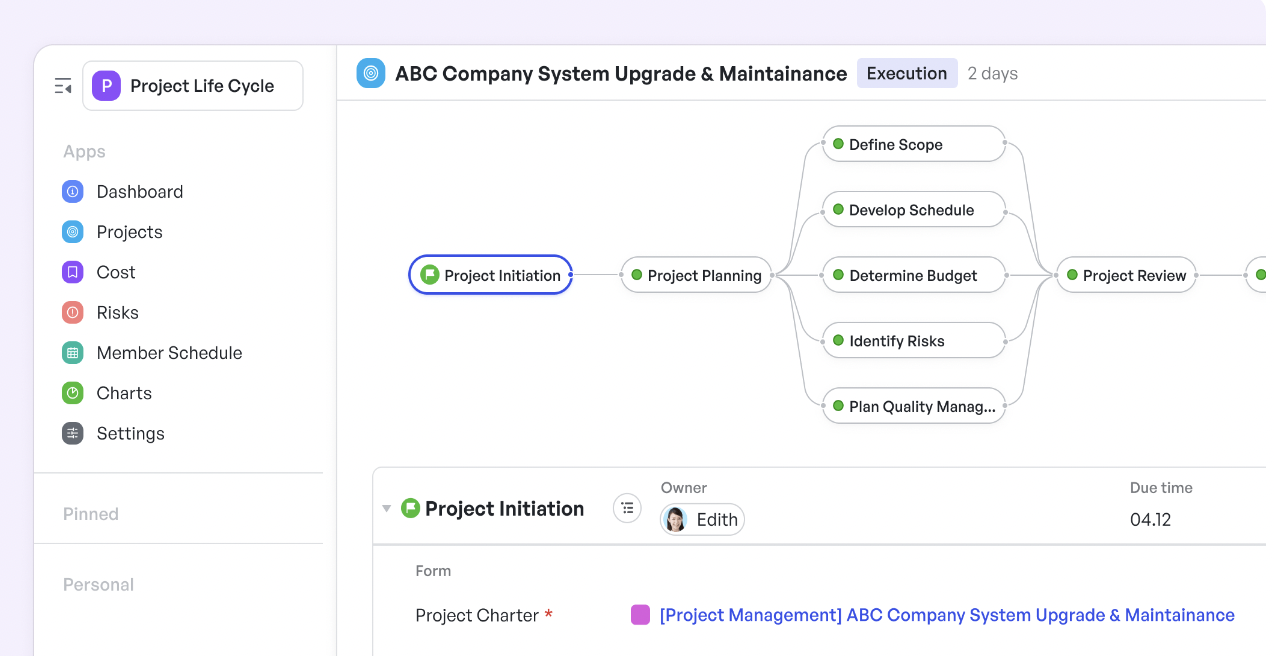 The Project Life Cycle Template by Meegle
The Project Life Cycle Template by MeegleAdditionally, Meegle offers the Project Life Cycle Template, ideal for IT teams working on technical rollouts or system integrations. It guides project managers through five distinct phases of the project life cycle:
- Initiation: Define scope, identify stakeholders, and clarify goals
- Planning: Build a roadmap including timelines, budget, and risk planning
- Execution: Mobilize teams and execute workstreams on schedule
- Monitoring and Controlling: Track real-time progress, manage exceptions, and refine plans
- Closing: Wrap up the project, capture lessons learned, and validate that technical, security, and performance standards are met
Because it supports collaborative work and structured delivery, this template works especially well for cross-functional IT teams operating in regulated or high-complexity environments.
5. Escalated issue management
In enterprise projects, unresolved issues can cause delays, inflate costs, and impact stakeholder trust. Escalation is a structured process that flags such issues early and moves them up the chain for faster, more strategic resolution. From vendor delays to persistent bugs and cross-team bottlenecks, escalation quickly raises critical issues to the appropriate stakeholders for prompt action.
The EPMO plays a central role in standardizing this process. It defines universal escalation criteria, creates shared protocols for action, and ensures issue visibility across departments. During management meetings, the EPMO reviews escalated items to:
- Identify patterns or systemic problems, such as conflicting sprint objectives or unmet vendor service agreements.
- Recommend targeted improvements at the team or organizational level.
- Allocate resources and actions based on the severity and urgency of issues.
To support this critical function, Meegle consolidates all open issues, including bugs, tasks, and technical debt, into a centralized platform that keeps everyone informed.
When a bug is reported, all supporting information, such as error logs, reproduction steps, and system impact, is captured in one place.
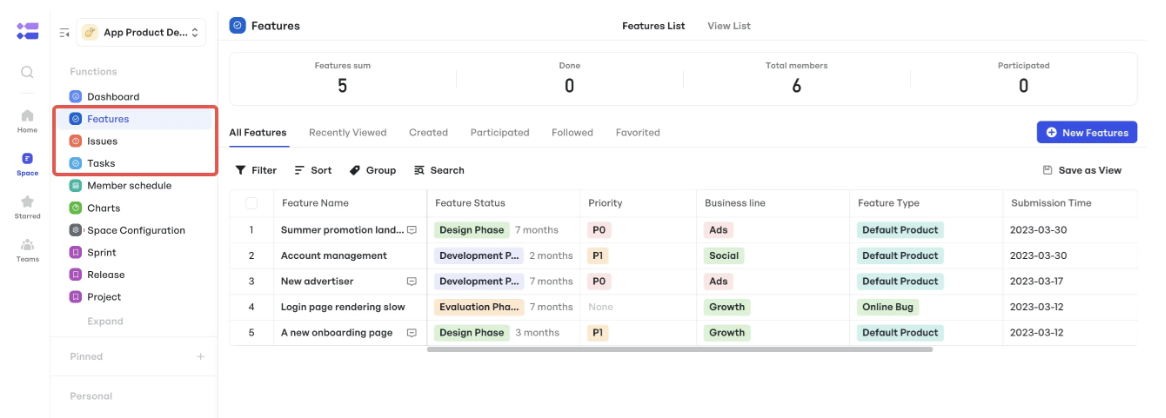 Issue tracking feature on Meegle
Issue tracking feature on MeegleThis centralization guarantees that:
- Developers, PMO, and executives reviewing issues have access to the complete context
- Teams avoid losing vital information during handoffs, reducing miscommunication and speeding up responses
Additionally, Meegle’s Git integration further streamlines escalation handling. When a developer references an issue number in a commit message, Meegle automatically links the code changes to the issue and updates its status in real time.
 Steps to connect your Git repository with Meegle
Steps to connect your Git repository with MeegleThis integration does more than save time; it creates a transparent audit trail that makes it easy to track:
- What’s being fixed
- Who’s responsible
- Where the issue stands
By surfacing real-time data across teams and tools, Meegle helps the EPMO and leadership to identify and track risks early, resolve blockers faster, and maintain project momentum even when challenges arise.
6. Time accounting
In enterprise project management, time is currency, and without accurate accounting, it's easy to overspend. A robust time tracking system allows EPMOs to understand where hours are going, across which tasks and teams, and use that insight to better estimate effort in future initiatives.
By aggregating data from individual and team timesheets, the EPMO can:
- Measure how actual effort compares to initial estimates
- Identify inefficiencies or scope creep
- Set realistic timelines based on historical benchmarks
While Meegle does not track time entries directly, its powerful scheduling and calendar management tools provide complete visibility into team availability and workload allocation.
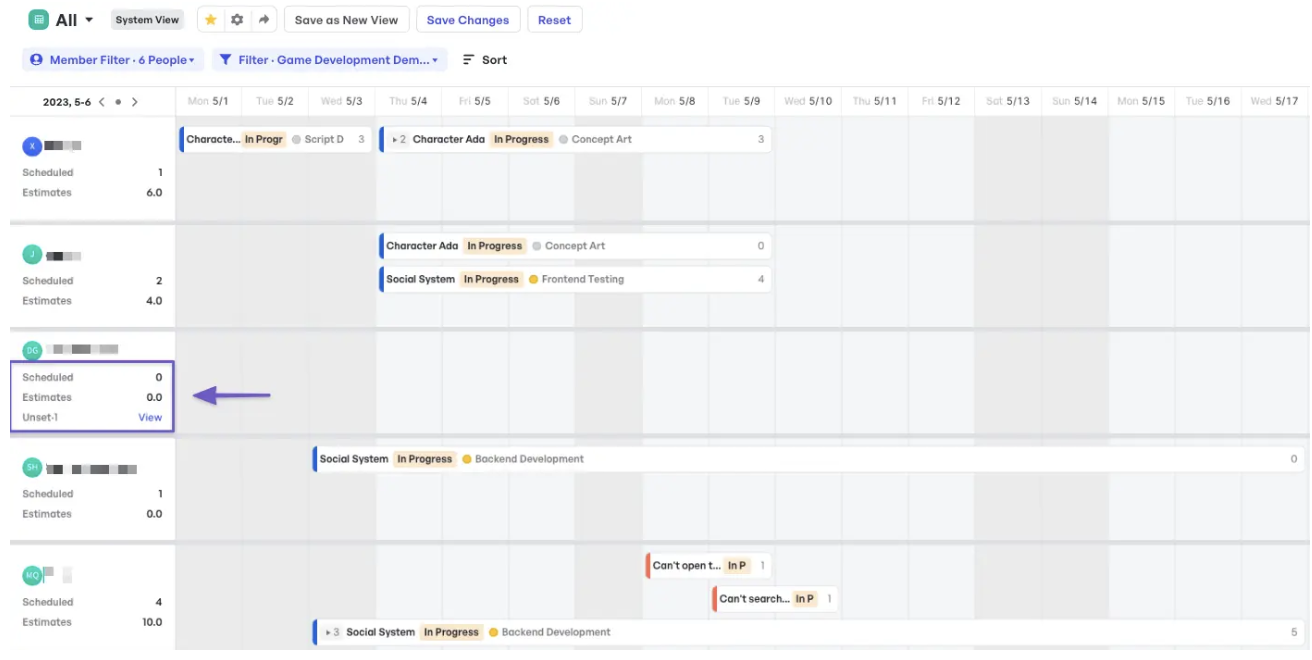 Manage your project calendar in real time
Manage your project calendar in real timeWith Meegle’s calendar management, you can see exactly who is working on what, and when. This granular view enables you to:
- Identify team members who are overbooked and at risk of burnout
- Spot unused capacity and quickly reassign tasks
- Adjust schedules dynamically using drag-and-drop functionality across Gantt Chart, List, or Panorama views
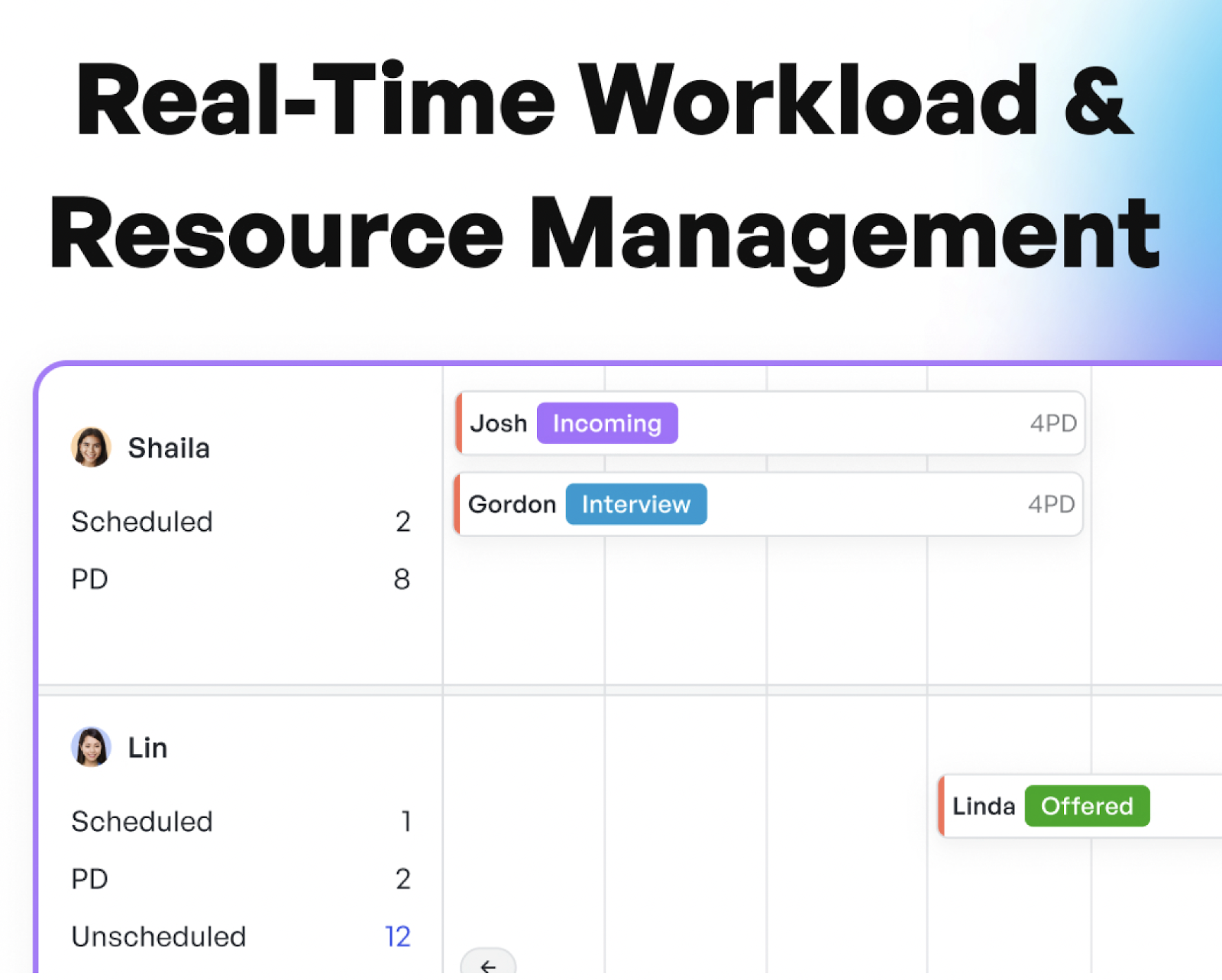 Quickly check each team member’s workload and fix resource bottlenecks by shifting task timelines as needed
Quickly check each team member’s workload and fix resource bottlenecks by shifting task timelines as neededThis level of insight enables the EPMO to balance workloads effectively, optimize delivery timelines, and uphold performance standards such as resource utilization, deadline adherence, and overall project efficiency across complex, multi-team projects.
7. Information system
An information system (IS) plays a central role in EPM by connecting the tools, workflows, and data needed to manage projects at scale. Rather than working from isolated spreadsheets or scattered point solutions, teams can access a unified environment that supports real-time coordination, tracking, and analysis.
A well-integrated IS enables:
- Consistent data flows across departments, reducing misalignment and rework
- On-demand access to project insights, helping leaders act on what’s happening now, not what happened last week
- A common framework for tracking progress, managing risks, and adjusting plans collaboratively
When embedded in an EPM approach, the information system becomes a living system that drives visibility, accountability, and better decision-making at every level of the organization.
How to implement enterprise project management
If your teams struggle to keep track of multiple projects or monitor progress effectively, it may be time to consider an enterprise project management (EPM) approach.
Start by assessing whether your company’s current structure supports EPM. This includes reviewing whether your current structure, culture, and tools can support a centralized, standardized model of project execution. Senior leadership, often in coordination with the EPMO or transformation office, should conduct a structured audit of existing workflows, communication patterns, and interdepartmental dependencies to identify friction points that could slow down adoption.
It’s essential to evaluate if EPM aligns with your company’s long-term strategy and goals. Consider factors like resource allocation, technology readiness, and team capacity for standardized processes. This upfront analysis ensures a smoother transition and maximizes the chances of success.
Step 1. Define the role of EPM in your organization
Before launching EPM, clarify its purpose and scope within your business. This begins by identifying specific challenges it should address, such as resource challenges, inconsistent delivery methods, or reporting blind spots, and outlining what success looks like.
To build a structure that fits your organization, start by answering key questions like:
- What responsibilities will the EPM Office (EPMO) have?
- What resources, including people, technology, and budget, are needed to support EPM?
- How will EPM align with and advance your strategic goals?
- Who will own EPM responsibilities, such as governance, training, and reporting?
This early alignment helps make your EPM approach both practical and purpose-driven from the start.
Step 2. Get stakeholder buy-in and involvement
Once you’ve defined EPM’s role, the next step is securing support from stakeholders across the organization. This involves more than presenting your EPM vision. It means articulating why it matters, how it aligns with business goals, and what changes will look like across teams.
To build confidence, emphasize practical benefits: smoother reporting, faster decision-making, greater team coordination, and more reliable visibility into project health. Make your engagement strategy concrete by:
- Clarifying how each stakeholder will contribute, from governance and approvals to reporting and communication
- Addressing common concerns such as reduced flexibility, increased oversight, or unfamiliar tools
- Highlighting early, measurable wins that show how EPM reduces rework, improves planning accuracy, or shortens delivery cycles
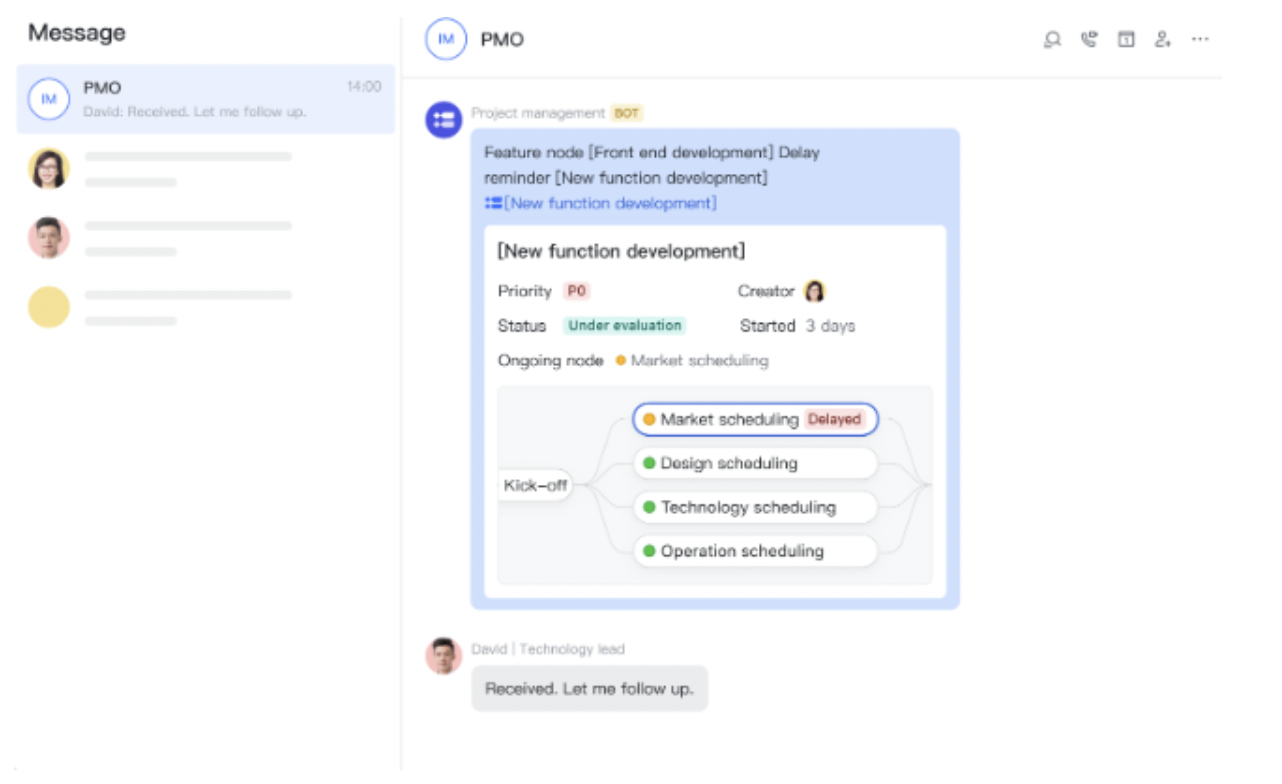 Keep stakeholders updated with clear visibility into project status and context
Keep stakeholders updated with clear visibility into project status and contextMeegle supports these strategies by automating transparency and enabling stakeholder engagement throughout the process.
Here’s how:
- Meegle sends smart notifications tied to project milestones, status changes, and approvals, so stakeholders stay in the loop without manually chasing updates
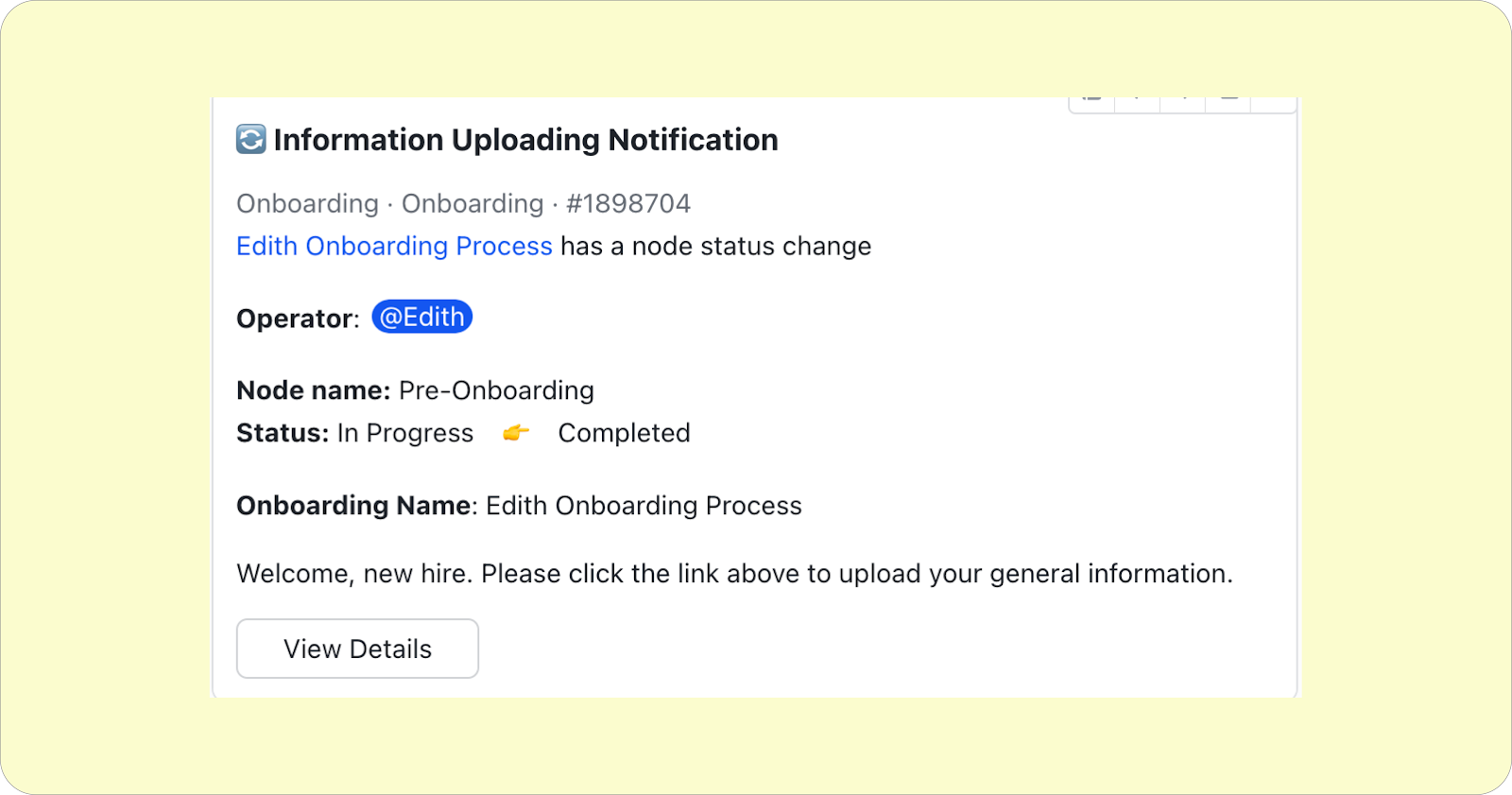 Automatically send notifications and initiate approvals as soon as tasks are marked complete
Automatically send notifications and initiate approvals as soon as tasks are marked complete- Its requirement grouping feature lets PMOs create stakeholder-specific views and communications with one click, keeping every message relevant and clear
- Each update includes embedded context (like task owners, blockers, or delivery dates), making it easier for leadership to weigh in without needing to request more information
This reduces the communication burden on project managers, freeing them to focus on strategic alignment rather than tactical updates. At the same time, stakeholders receive exactly what they need at the right time to stay engaged and support the broader transition to EPM.
Step 3. Roll out EPM processes gradually
Implementing EPM is not a single event, but a phased transition. Start by defining a clear implementation roadmap with phased milestones. Break down what needs to change: roles, tools, workflows, and governance models. Then, align each phase with training and measurable outcomes so stakeholders can track progress and contribute feedback along the way.
Strategically, this gradual rollout helps teams:
- Adjust without being overwhelmed
- See early wins before full adoption
- Adapt processes based on real-world results
How Meegle supports a phased rollout
Meegle supports this iterative approach with an interface built for easy onboarding and scalable deployment.
Here’s how:
- Meegle’s intuitive design shortens the learning curve, so teams can quickly adopt new processes without extensive training cycles
- You can start with a single workflow or project, then expand by department or function. Use modular views like List, Kanban, Gantt, or Panorama to match each team’s comfort level and visibility needs
- As new phases go live, pre-built templates and guided setups help replicate standards without rebuilding from scratch, maintaining consistency without slowing progress
This helps teams test changes in real environments and improve them iteratively. By using Meegle as your rollout engine, you turn change management into an agile, data-informed process, one that evolves with your enterprise rather than forcing sudden disruption.
Step 4. Train teams on EPM tools and practices
Training is essential for embedding enterprise project management practices across the organization. So, equip teams with the knowledge, tools, and confidence to work within the new system. To do this, start by offering interactive sessions that cover both the “why” and the “how” behind EPM, focusing on workflows, roles, and reporting expectations. Tailor the content to different departments to make it relevant and actionable.
To support this, Meegle makes EPM training easier and more effective. It's built-in templates walk users through every phase of project delivery, while views help teams visualize work in ways that suit their function. You can also create role-specific dashboards and documentation libraries directly within the platform. This allows team members to self-serve answers and develop fluency at their own pace.
The result? Faster adoption, greater consistency, and fewer support requests.
Step 5. Integrate EPM tools with enterprise software
For enterprise project management to truly deliver value, it must operate within your organization’s existing software ecosystem. Projects are closely linked to sales pipelines (CRM), budgets (ERP), HR schedules (HRMS), and marketing performance. Syncing EPM tools with these systems creates a connected environment that enables informed, real-time decision-making.
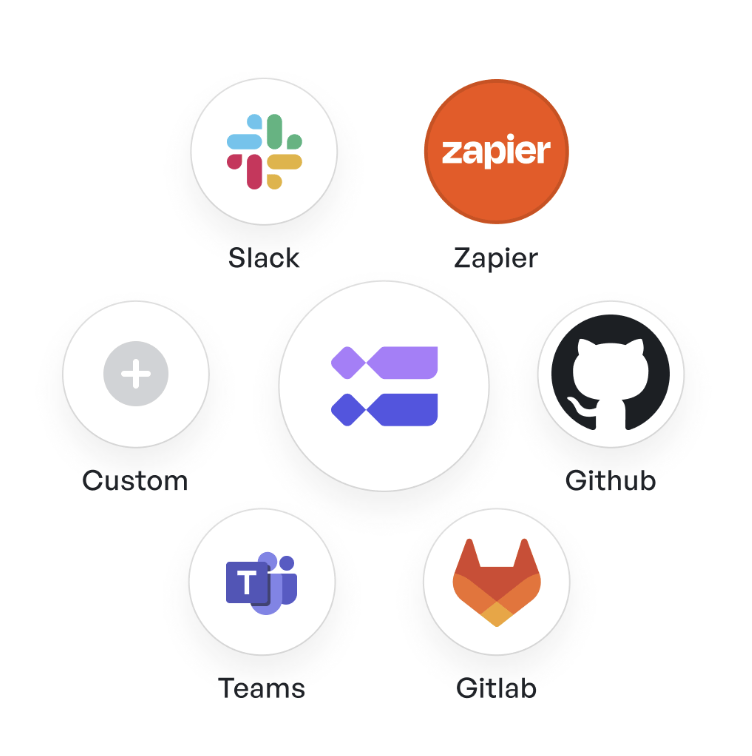 Meegle integrations
Meegle integrationsMeegle integrates with existing systems through pre-built connectors and automation triggers, allowing EPM to operate smoothly within your broader enterprise strategy. It connects with project management tools like ClickUp, communication platforms like Slack and Microsoft Teams, and marketing software such as HubSpot, creating a real-time information loop that keeps everyone aligned.
For example, when a stakeholder leaves feedback in Slack, Meegle can trigger a task, assign the right owner, and start tracking it instantly.
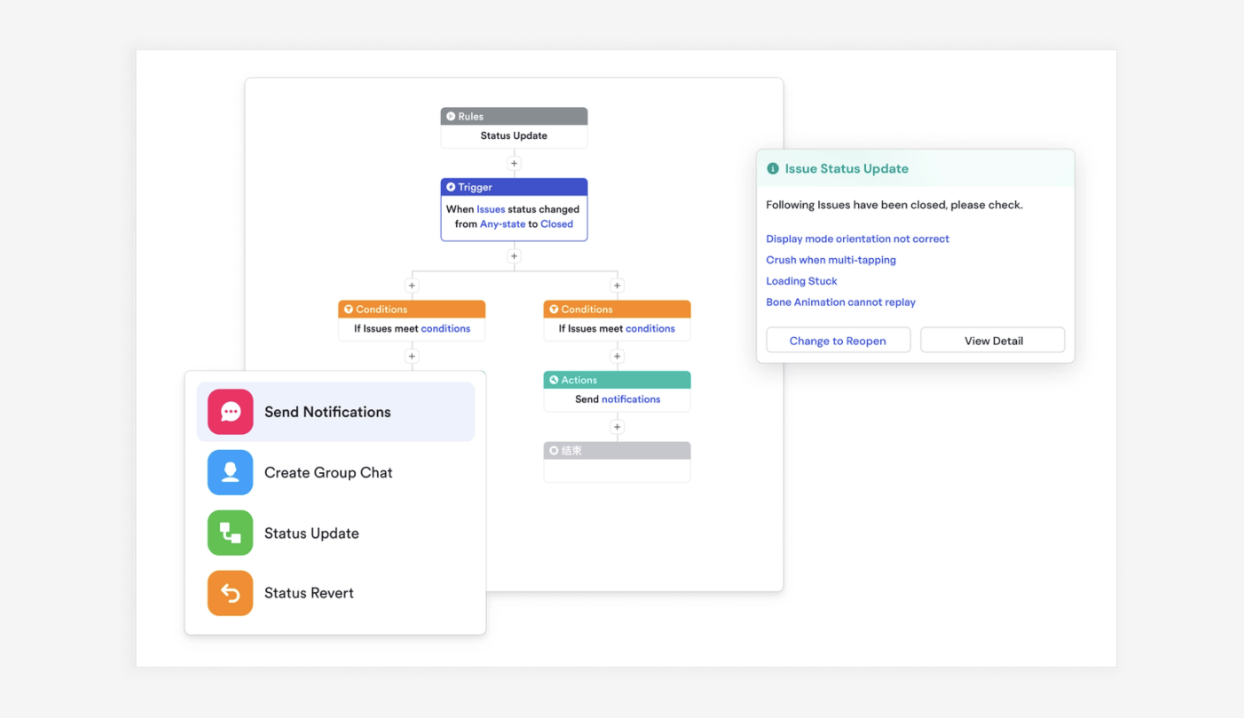 Keep stakeholders updated and collaborate efficiently through centralized dashboards that display real-time project data
Keep stakeholders updated and collaborate efficiently through centralized dashboards that display real-time project dataIn healthcare, construction, or marketing industries, Meegle routes stakeholder feedback from integrated channels directly into live project boards, enabling real-time response loops and keeping projects aligned with shifting priorities.
Finally, Meegle's automation tools prevent progress from stalling due to human delays. Here’s how:
- Tasks are auto-assigned based on skill, role, or bandwidth
- Reminders and approvals are sent without manual input
- Progress reports are generated and shared with leadership on specific criteria
This kind of strategic integration makes EPM a living, breathing part of your enterprise operations.
Step 6. Monitor and adjust based on performance data
An effective enterprise project management strategy begins by defining clear performance goals and selecting relevant Agile KPIs to measure delivery success and team efficiency. Next, it involves tracking tool adoption and feature utilization to ensure teams are using them effectively to support workflows. Finally, regularly reviewing this data helps identify gaps or inefficiencies and guides timely course corrections.
Meegle supports these efforts with real-time dashboards and performance charts that visualize key Agile KPIs, including:
- Delivery pace
- Story points completed
- Burndown rate
- Blocker frequency
These insights help project leads identify trends like consistent scope creep or sprint delays and adjust sprint planning or resource distribution accordingly.
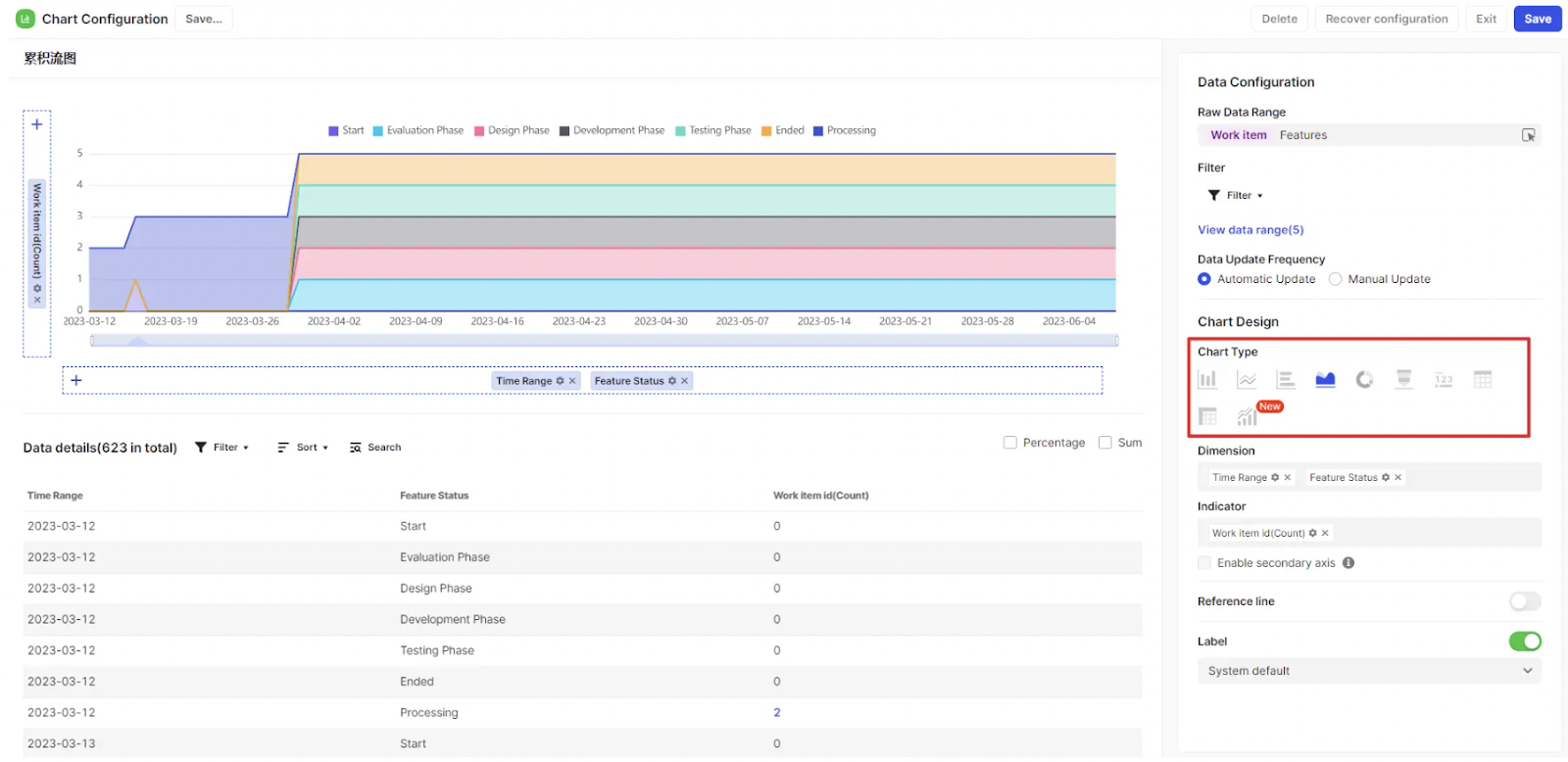 Visualize your data with charts
Visualize your data with chartsYou can customize your view with line, bar, or pie charts to analyze the data most relevant to your team. Pie charts highlight metric distributions, while line graphs reveal trends over time, offering deeper insights into changes in performance, team sentiment, or engagement. This combination helps teams not only track data but also understand the story behind the numbers, enabling early problem detection and swift action
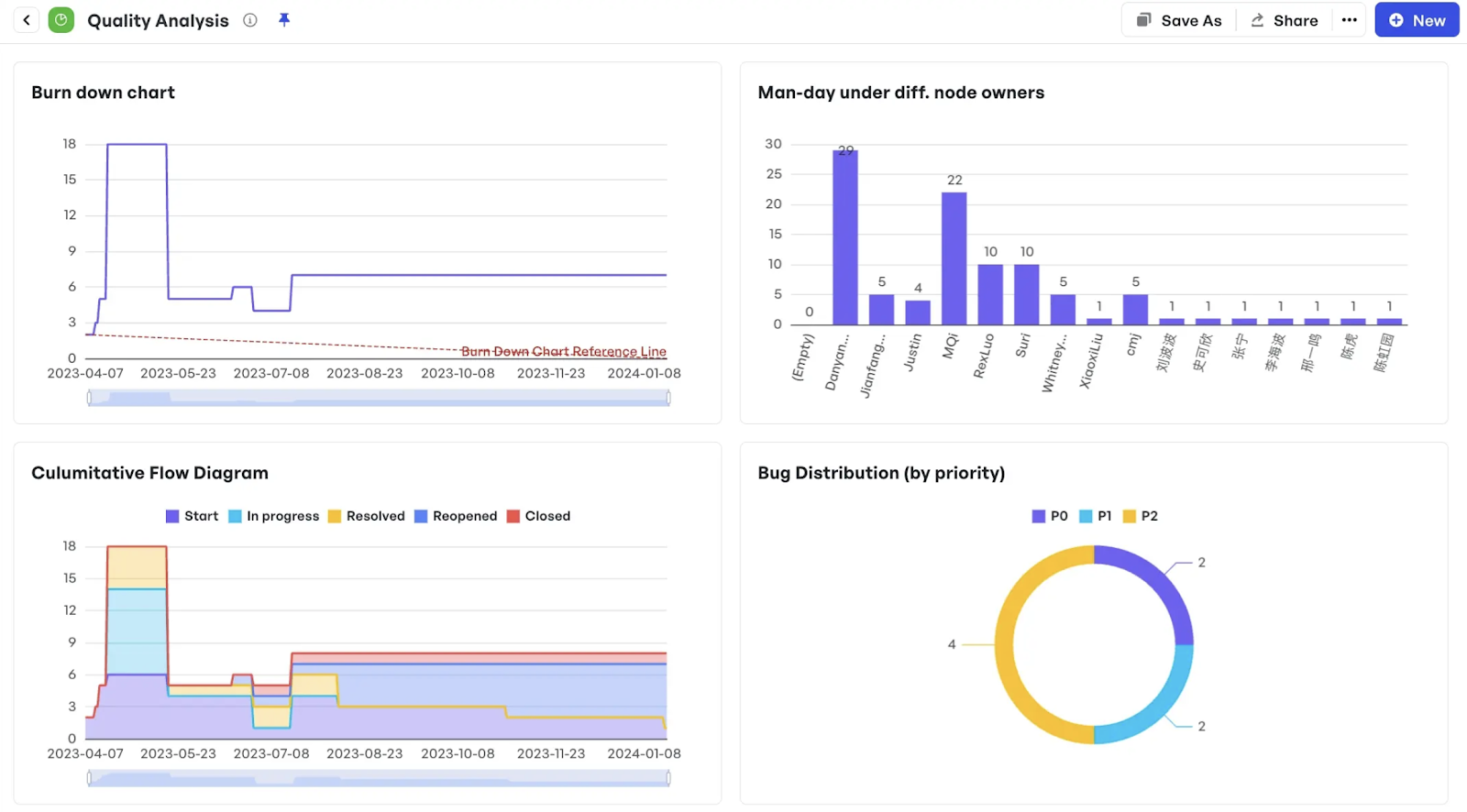 Identify sprint slowdowns early with burndown charts
Identify sprint slowdowns early with burndown chartsFor example, if burndown charts show that progress regularly slows mid-sprint, you can look into backlog grooming issues or task distribution. By making these adjustments early, EPM leaders can keep projects moving forward and improve the execution quality across portfolios.
Step 7. Establish feedback loops to improve maturity
Scattered, unstructured feedback, spread across Slack, email, or disparate tools, slows decision-making and risks losing critical insights. Meegle enables structured, contextual collaboration by embedding feedback directly into each task using built-in commenting and voting and @mentions. This keeps conversations focused and accessible without forcing users to switch platforms.
 Leave feedback directly inside tasks
Leave feedback directly inside tasksEvery suggestion, revision, and decision is logged and traceable within the task’s history, supporting accountability and knowledge retention. Meegle also automatically notifies relevant stakeholders about updates such as comments, deadline changes, or status shifts, ensuring timely responses.
This approach not only improves alignment throughout the project lifecycle but also builds a rich repository of institutional knowledge that teams can reference to accelerate future initiatives and continuously improve project maturity.
Is enterprise project management (EPM) right for your organization?
If your business struggles with project alignment, visibility, or resource coordination across teams, EPM can bring clarity and control. It’s especially valuable for organizations managing multiple complex projects that impact strategic goals.
However, successful adoption requires commitment to standardized processes and possibly structural changes. While smaller companies with simpler project portfolios may not require full-scale EPM right away, the approach becomes increasingly valuable as organizations scale and seek consistent, efficient delivery. Evaluate your current project challenges and long-term goals to decide if EPM aligns with your strategy for sustained growth and improved outcomes.
How Meegle helped Skylink Studio revolutionize game delivery
Skylink Studio, a top Vietnamese game developer, struggled to coordinate ideas and track progress across a 50-person team handling multiple projects. Meegle brought clarity and organization to their process, transforming how they manage game development.
Structured roadmapping with Tree View
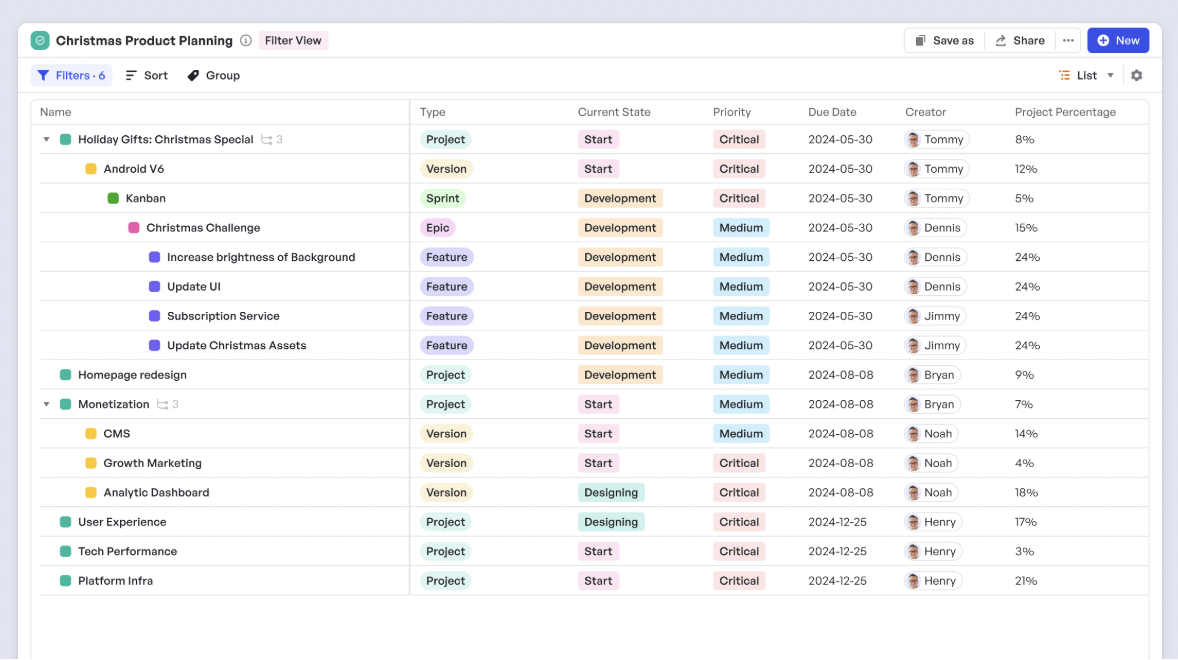 Skylink's product roadmap with Meegle's Tree View
Skylink's product roadmap with Meegle's Tree ViewUsing Meegle’s tree-view and panorama views, Skylink broke down their flagship MagicSwap App into manageable levels, from overall project themes to versions, sprints, epics, and individual tasks.
This hierarchy kept the team aligned and focused on delivering exceptional games.
Workflow accountability and notifications
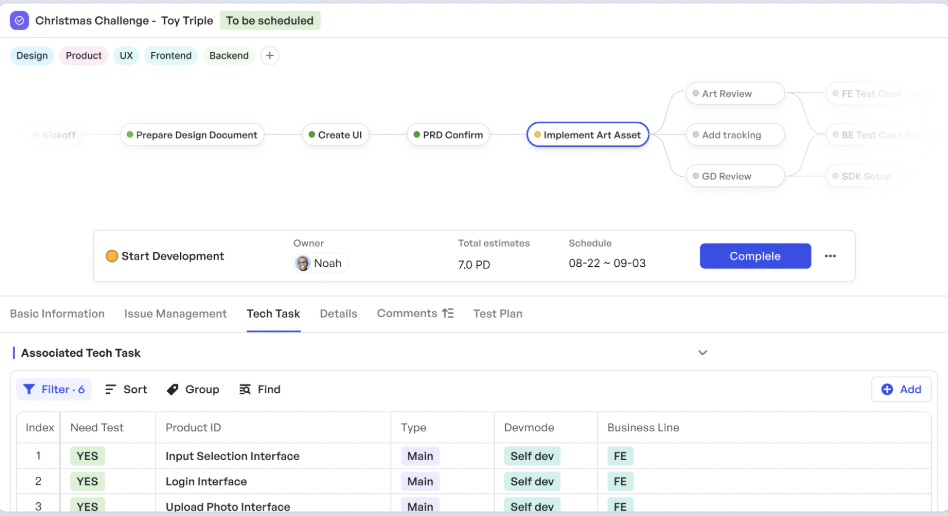 Skylink's visual workflow for Toy Triple
Skylink's visual workflow for Toy TripleMeegle’s visual workflow mapped key milestones, ensuring foundational tasks like design prep and UI creation were completed before development, reducing delays.
Task owners received automated notifications, enhancing accountability and priority clarity.
Progress tracking with dynamic charts
Skylink used Meegle’s dynamic charts to monitor project health in real time. They tracked bug counts, feature implementation, and sprint velocity, quickly identifying blockers and reallocating resources as needed.
This insight kept timelines on track and improved team responsiveness during critical release windows.
As Project Manager Khiêm Trần says, “Meegle has been a game-changer for our projects. I love how its features make it easy to visualize everything in one place. It’s incredibly helpful to have a clear view of the project’s progress and the goals we’re working toward, allowing everyone on the team to stay aligned and focused."
With Meegle, Skylink overcame the chaos of handling multiple projects. Logistical hurdles that once caused delays gave way to a clear, centralized system, allowing the team to create unforgettable games for players around the world
Step into enterprise-level project management
Enterprise project management is about gaining control, clarity, and coordination across complex initiatives. As organizations scale, so does the need for structured estimating, standardized workflows, and real-time oversight.
Meegle supports this shift by embedding discipline into every phase of the delivery process. From guided planning templates to stakeholder tracking and performance dashboards, it provides the structure to manage complexity while maintaining momentum.
Discover how Meegle can support portfolio-wide planning, clear ownership, and streamlined collaboration across enterprise teams.
FAQs
What is the difference between a PMO and an EPMO?
A PMO manages individual projects or departments, while an EPMO applies enterprise project management methodology to oversee and align all projects across the entire organization with strategic business goals.
What is the role of an EPM?
An EPM coordinates multiple projects across the organization, standardizes processes, manages resources, monitors risks, and connects projects to company objectives to deliver overall business value.
How does enterprise project management improve decision-making?
Enterprise project management methodology provides centralized data and real-time insights, allowing leaders to make informed decisions that balance risks, resources, and business priorities across multiple projects.
The world’s #1 visualized project management tool
Powered by the next gen visual workflow engineRead More
Check All BlogsStart creating impactful work today



